Tai Chi Chuan - Yang style Push Hands Training with multiple generations of Yang style practitioners.
Tuesday, December 30, 2014
Sunday, December 28, 2014
Friday, December 26, 2014
Wednesday, December 24, 2014
Monday, December 22, 2014
THE KUNWU SWORD MANUAL OF LI LINGXIAO - Paul Brennan Translation
昆吾劍譜
KUNWU SWORD MANUAL
李凌霄
by Li Lingxiao
[published Feb, 1935]
KUNWU SWORD MANUAL
李凌霄
by Li Lingxiao
[published Feb, 1935]
[translation by Paul Brennan, July, 2013]
FOUND: HERE
-

著者肖像
Portrait of the author
-Portrait of the author
序
PREFACE [BY YIN JINGCHUN]
余素嗜國術,每遇國術專家,輒欲與一談,藉覘其研究之造詣及專擅之特長,以探我國武術之奧秘。十餘年來,所接談者不下數十名家;參觀出場比賽之名手,不下數千百人。或以剛猛致勝,或以敏捷取巧,或鍛鍊身體之一部以享盛名,或洞貫器械之全能,而自成一派。然一藝之精,舉非窮年累歲不為功。吁!國術之淵邃,信非門外漢可得而言也。
民國十八年,余來滄中任敎職,得晤李凌霄先生。先生世居滄縣西門外,為滄中國術導師,雖武夫而循循有儒者氣。暇與暢談,始知先生擅內外功。一日,令學生試舞昆吾劍。細觀之,與姜著寫眞昆吾劍出入甚多,因與談劍。於是又知先生精通劍法焉。
間嘗披覽馬相伯及姜容樵諸先生所著各種劍法。頗喜其論證宏博,條理貫通。然語其細膩精微,則先生又有說焉。余不禁驚詫而言曰:劍術之所以為劍術,其價値在於是矣!蓋身隨劍轉,劍掩身形,發手如閃電,駐足如磐石,紆迴婉轉,忽疾忽徐;所謂如游龍,如翔鳳者,信得舞劍之姿態矣!
昔之雅士,每以琴劍自隨。今之聞人,亦往往以習劍為樂。然大多公餘少暇,殊難作深邃之鑽研。即有志追求,而眞正精專之導師,一時又難遇合。且以國術在我國原屬秘傳。粗通者不敢遽以授人,精通者又不肯輕以授人。中國國術之日就淪湮,實由於此!
今者中央及各省縣蓋均有國術館之設。但鄕野精專國技之士,豈能盡為網羅;而功力湛深之專家,又未必能文詞以傳其藝業之奧。因之提倡者僅具苦心而難收美滿之效果。先生精於術而粗通文,因慫恿以昆吾劍譜公之於世,以存劍術之眞面目而供國術界之研索焉。
噫!劍之路數夥矣。因有派別之分,遂各是其是。然差之一毫,謬以千里。學之不精,遽失本原。習國術而能觀其會通,一洗派別之見者,海內實不多覯。先生挾其術奔走南北,所遇名手難以數計,一經接觸,蓋莫不服其神化焉。昔曹仲珊見而賞之,李協和聞而愛之,張之江見而喜之,豈不以其技術之精妙哉?
李君所遇如此,竟甘回鄕授徒以自樂。是則先生之所以過人者,不僅在其技術也已。房山殷景純序。
I have always been addicted to martial arts. Whenever I meet martial arts experts, I always want to have a conversation, to take the opportunity to find out about what they have achieved through their studies and about their particular specialties, so as to explore the wonders of our nation’s martial arts. More than ten years ago, there was an occasion in which I got to meet and talk with no less than ten noteworthy experts. It was at a competitive gathering of famous practitioners that had attracted a crowd of over a thousand people. Some of the competitors won through hardness and fierceness, others through nimbleness and ingenuity. Some enjoyed a great reputation for having built up their bodies, while others had a thorough ability with every kind of weapon and had created their own systems. And the essence of any one of their arts is that if it is not worked at for years upon years, there will be no skill. Indeed the profound depth of martial arts is truly beyond the grasp of laymen.
In 1929, I came to Cang county to take up a high school teaching position, where I met Li Lingxiao. He had lived there his whole life beyond the west gate and was the martial arts instructor in the Cang county high school. Although a martial man, he has the dignified air of a gentleman. Talking freely in our spare time, I began to be aware of his prowess in both internal and external skills. One day, he told a student to perform the Kunwu sword set so I could take a look at it. Carefully observing, I noticed it diverges in a great many ways from Jiang Rongqiao’s Authentic Kunwu Sword [1930]. I then discussed the sword with him, whereupon I realized his mastery of the sword art.
I have experienced the sword methods of Ma Zizhen and Jiang Rongqiao. I was quite delighted by their extensive discourse and methodical understanding. Li also has remarked upon their profound fluency. I cannot help but state from my amazement that the reason the sword art is the sword “art” is because of such quality as theirs. The body goes along with the sword’s rotations while the sword covers over the body’s shape. The hand shoots out fast as lightning, the legs standing solid as a boulder. It is roundabout and indirect, suddenly fast, suddenly slow. It is said that one who performs it “like a swimming dragon, like a soaring phoenix” has truly obtained the sword’s attitude.
Sophisticated gentlemen all used to use the zither and the sword as means to express themselves. Famous men nowadays also are often practicing the sword art for their amusement. But for the most part they do not have enough free time, and so it is especially difficult for them to make a deep study of it. Though they may have an ambition to pursue it, the opportunity to meet with an instructor who is a genuine expert is hard to come by. Moreover, the martial arts of our nation were originally a kind of esoterica that was kept only in the family. Those with only a rough understanding do not have the confidence to jump into teaching, while those who are experts are not willing to teach just anyone. The day of Chinese martial arts is long gone, and surely these are the reasons why.
Nowadays, martial arts institutes have been founded, both centrally and in the provinces. But as for the excellent martial artists in the countryside, what can be done to fully bring them into the project? Though their skills may be profound, they are not necessarily sufficiently literate for the task of passing down their art’s secrets. As they can be recommended only for their hard work, it is difficult to harvest a fully satisfactory result. Because Li is such a one who is highly proficient in the art yet somewhat deficient in literacy, I instigated this project of sharing this book with the world, for the sake of preserving the integrity of the genuine sword art and to supply the martial arts world with study materials for it.
There are so very many sword sets due to the multitude of styles, and each thinks their way of doing it is the right one. But to miss by an inch is to lose by a mile. If it is not learned with precision, one will quickly end up violating fundamental principles. To be able to observe examples of mastery while practicing martial arts, to get to watch someone who is totally immersed in a style, is really an uncommon experience in the world. Li carried his art around in a frantic quest north and south to meet with more famous practitioners than can be counted. At the first moment of contact, they were each convinced of his magical prowess. When Cao Zhongshan caught sight of his skill, he so admired it. When Li Xiehe heard about it, he was full of appreciation. When Zhang Zhijiang looked upon it, he was utterly delighted. So how could his skill not be exquisite?
When I met Li, I felt the same as they did. Once he had finished this project to his satisfaction, he returned home to teach students for his own pleasure. This is why he is so much better at it than others, not just because his skill is superb.
– written by Yin Jingchun of Fangshan [district of Beijing]
-
自序
AUTHOR’S PREFACE
昆吾劍之遠源,吾不得而知之矣。蓋是劍以器名也。
昔周穆王伐昆戎,昆戎獻昆吾之劍。列子載:「錕鋙之鍊鋼,可以切玉。」故昆吾劍乃古之寶劍也。有劍器,斯有用法。未有炮火之前,我國武士全恃長兵短兵以應敵。累世相傳,愈研愈精。以術名者,歷代不乏其人。後世精專之士,各以宗法,自立門派。或假劍器以名劍法,如昆吾,靑萍之類,蓋亦尊古之意也。有淸道光初年,我縣城東北軍馬站戴三先生擅武術名。一日,有江南人劉姓者,夫婦二人,持劍來訪。戴君遜謝不敏。劉某曰:「余慕名而至,非來與汝較高下,但欲窺汝派之手法耳。」戴君不得已,遂出己藝與之較,而出手便為所制。屢試皆然。戴君遂棄劍而言曰:「是吾師也。」因挽劉君於家,而日夕就學焉。居一載有半。濱行,曰:「余平生專嗜此術,故走南北以訪高明之士,竟未一遇。今轉以余藝授汝,亦極大緣分,弗可輕以示人!」遂辭去。其後,戴君授於李天穆家辛莊劉振祥。余從劉先生學而未精。後遇戴三先生之侄於大連,因朝夕探究,始得其奥。雖然,敢謂此劍遂能包括一切劍法乎?但就余所習,及所見者而言,蓋舉不若是劍之超妙有法也。房山殷景純先生,文人而嗜國術者也。覩此劍法。詫為希有。以為値國家提倡國術之時,亟應付梓,以供同好之研究。因商同殷先生將原譜重加修訂,附以着法,加以圖說。俾學者不僅得舞劍之姿式,並能明其用法;按圖索驥,逐步推敲,練習旣熟,再從中求其變化,期年可以有成。則於劍術之道,可以得其大凡矣。至若故神其說,先語人以難能;旣學之後,又茫乎不得要領,舉手而受制於人,又何貴學劍術哉!然末學寡聞,愚者一得,深盼海內專家,有以敎正之,則幸甚矣。民國二十三年七月滄縣李凌霄序。
I am not sure about the source of the Kunwu sword art, but the sword of that name is famous. In the ancient Zhou era, King Mu sent an expedition against the Kun tribe in the west, who then presented as tribute to him the sword of Kunwu. Liezi wrote [Liezi, chapter 5]: “The sharpness of the Kunwu sword could cut through jade as if it was mud.” Therefore the Kunwu sword was a precious sword even in ancient times.
There was the sword, and then there was the method. Prior to the days of cannon fire, our nation’s warriors relied entirely on long weapons and short weapons to deal with enemies. These arts were passed down through many generations. The more they were worked with, the more they were refined. History has no lack of famous experts. Later generations of them developed a sectarian mentality and established their own styles. Some sword arts were named after actual swords, such as Kunwu and Qingping, with the intention of gaining the respectability of being associated with something ancient.
In the first year of the Qing emperor Daoguang’s reign [1821], in the town of Dongbei in my home county, Jun Mazhan and Dai San were well-known as being good at martial arts. One day, there was a married couple from Jiangnan surnamed Liu who were holding swords and had come for a visit. Dai declined them humbly but not wisely. Mr. Liu said: “I esteem your reputation and have not come to challenge you, but I wish to have a look at the hand techniques of your style.” Dai had no choice but to exhibit his style by way of a bout with Liu, but whatever he did with his hands was easily controlled no matter what he tried. Dai then handed over his sword and said to Liu: “You are my teacher.”
Thereupon he took Liu into his home and learned from him day and night. Liu stayed for a year and a half. As he started again on his journey, he told Dai: “I have been addicted to this art my whole life. This is why I have traveled north and south in search of the most brilliant experts, and I have to keep on looking. That it has now turned out that I have taught my art to you was all a matter of destiny. You must not casually show it to people.” When he finished saying this, he left.
Later, Dai taught it to Li Tianmu, Jia Xinzhuang, and Liu Zhenxiang. I learned it from Liu Zhenxiang but did not yet master it. Later I met Dai San’s nephew in Dalian [city in Liaoning], and hence worked at it every day until I began to obtain its secrets. Although I would not dare to claim this sword art contains every possible sword technique, I would say from what I have practiced and what I have seen that its techniques surpass those of other sword arts.
Yin Jingchun of Fangshan is a scholar who is addicted to martial arts. When he saw this sword method, he was surprised by its uniqueness. As he has been promoting the worth of martial arts to the nation, he urged me to publish it to supply study materials for those with the same interests. Based on discussions with Yin, I now present this manual after repeated revisings. Included are application explanations and photographs so that students will not only achieve the performance of the sword postures but also be able to understand how to use them.
By referring to the materials to get the idea, you will systematically progress to a polished level. By practicing it until you are skillful at it and then working toward its quality of adaptability, you can succeed at in a year. You thereby can obtain the general idea in the ways of the sword art. But as for its spiritual aspect, I will tell you in advance that is more difficult to attain. After learning it, many become too busy with other things and never achieve its essentials, and then when they put up their hands to fight, they end up controlled by their opponents. What kind of way is that to value the study of the sword art?
Yet my own knowledge is so limited, whatever I have gotten right in here was by sheer luck. I sincerely hope the nation’s experts will give me corrections, for which I would feel blessed indeed.
– written by Li Lingxiao of Cang county [in Hebei], July, 1934
-
劍箴十條 此十條現在已無庸叙及茲特存之以見古人用心之苦亦以見此劍之珍貴也
TEN CAUTIONS IN THE TREATMENT OF THE SWORD ART
(These ten things are rarely talked about anymore, but through them we can get a sense of the painstaking effort of ancient people and come to see this sword art as something precious.)
一劍術自古所傳不一,而昆吾之法,最為上乘。學者不可目為尋常,當珍重視之。
[1] A variety of sword arts have been passed down since ancient times, but the Kunwu method is the best of them. You must not look upon it as something ordinary, but should instead regard it as a treasure.
一劍之為器,可伴琴書,非尋常武器可比。愛之者須於潔淨處藏之。
[2] The sword is an implement that fits well alongside music and literature. There are no ordinary weapons that can be compared to it. If you are one who cherishes it, you have to store it in a place that you keep especially clean.
一劍惟三家可傳,儒家,道家,將家是也。然猶須擇其端正儒雅者授之。
[3] There are only three kinds of people who can be taught the sword art: Confucianists, Daoists, and strategists, for such people have the required qualities of uprightness and elegance.
一劍有十不傳:人品不端者不傳。不忠不孝者不傳。人而無恒者不傳。不知珍重者不傳。文武不就者不傳。藉此求財者不傳。俗氣入骨者不傳。市井人不傳。拳脚行不傳。何也?恐有玷於昆吾之高尚也。
[4] There are many kinds of people who are not to be taught the sword art: those without honor, the disloyal or unfilial, those without perseverance, those who do not understand the value of taking caring of oneself, those without a balance between the civil and martial, those who are looking to make money out of it, those with crass personalities, the street performers, and bullies. Why? For fear such people would disgrace the integrity of Kunwu.
一劍有五戒:一戒自矜,二戒務名,三戒好與人爭勝,四戒好殺,五戒目空一世。
[5] Five things to avoid in the sword art: 1. bragging, 2. seeking fame, 3. finding enjoyment in defeating others, 4. finding enjoyment in destroying others, 5. and looking upon life as if it does not matter.
一可傳之人不傳,失人。不可傳之人而傳,失劍。如認人不眞,寧失人勿失劍。自古皆然,非吾輩之吝也。
[6] If someone can be taught yet is not taught, that is a waste of the person. If someone cannot be taught but is taught anyway, that is a waste of the sword art. When considering whether a person is right for it, it is better to waste the person than to waste the sword art. It has been thus since ancient times and is not a stinginess from our own generation.
一傳劍先須擇人,又須擇地。濁亂之處,雖有可傳之人,恐其操持不堅,漸為惡人所得,貽害不淺。
[7] In teaching the sword art, you first must select the student, and then you must select the environment. If you are teaching in a messy and distracting place, then even if the student is one who can indeed be taught, his grasp of it will not be very solid. You will gradually turn him into a bad student, and the harm you pass down [not just to him but to his future students and to the future of the art itself] will not be slight.
一學者必須愼秘,切不可於廣衆之中,輕於衒弄,以博美名。恐惡人見愛,求之不得,反以結怨。
[8] You need to be cautious. When in the midst of the multitude, you must never lightly show off in order to win a good reputation. It is likely that the wrong sort of person will see it and fall in love with it, and then when he is not able to get anything out of it even though he tries, you will only have caused resentment.
一劍乃世所罕有,始為人所甚慕。倘遇不得眞傳,自鳴得意,任其狂誖,不必與之爭辨。
[9] The sword art is such an exceptional thing that it is a source of envy. If you encounter someone who has not obtained the true teachings yet croons on and on about how great he is and thinks he knows everything, it is not necessary for you to have an argument with him.
一旣得眞傳,又須涵養性情。倘遇無知之徒,妄加譏貶;只可令其一世糊迷,不必與之較量。
[10] Once you have obtained the authentic teachings, you must then be restrained and discipline your own temperament. If you encounter someone who does not know what he is talking about and hastily slanders others, you ought to merely point the way to reducing his lifetime of confusion. It is not necessary for you to have a bout with him.
-
對劍要領
ESSENTIALS OF SPARRING WITH THE SWORD
——此劍不封不架不沾而進——
– This sword art does not use sealing, propping, or sticking, and yet finds a way in. –
待敵恃奇正。追敵須奪門。莫使人佔手。起伏要分明。欲左先攻右,欲右先攻左。人如分心刺,提爐中攔行。人若照頭砍,藤蘿妙無窮。若是刺膝足,懸斬莫消停。人欲砍我腿,下攔最分明。如橫抹我項,領衣式可贏。若彼斬裏腕。施鞭抹式工。如砍左額角,飛空上斷贏。如取右額角,閉門下式靈。如要正刺手,折梅法最精。如取內一寸,底抹可成功。若斬外一寸,底抹過門通。如攻內二寸,縮斬必然行。如取外二寸,外捲式最明。若取內三寸,外撩刺脅精。如取外三寸,捕鼠式最工。彼攻內四五,黃龍頭手冲。彼攻外四五,三斷驚風行。彼用連環式,擺尾捲手贏。人內斬我手,三里次手工。人用外斬手,內撩兼刺胸。下來用滴水。上來挑手明。進退俱有法,要着習貴精。式多難盡述,功到自然成。
I await the opponent with both orthodox techniques and surprises. When I chase after him, I must control the gateway. I do not allow him to position his hands. Rising and crouching should be distinct. When I want to go to the left, I first attack to the right. When I you want to go to the right, I first attack to the left.
If he stabs to my solar plexus, I use SPARKING THE FURNACE to block off the middle.
If he wants to chop to my head, the VINES CLIMBING THE WALL is limitlessly effective.
If he wants to stab to my knee or foot, I upset his plans with a hanging slash.
If he wants to chop to my leg, a low block is the most obvious thing to do.
If he goes across with a smearing technique to my neck, WIND TUGS THE ROBE will defeat it.
If he slashes to the inside of my wrist, I whip forth with a smearing technique.
If he chops to my left temple, FLYING INTO THE SKY will stop him above to defeat it.
If he goes for my right temple, closing the door with a low posture is best.
If he wants to stab straight to my hand, the technique of PLUCKING A PLUM is best.
If he wants to get inside an inch, a smear underneath can succeed.
If he wants to slash outward an inch, a smear underneath can pass through his door.
If he attacks two inches inward, a retracting slash will surely work.
If he attacks two inches outward, an outward rolling technique will have the clearest result.
If he attacks three inches inward, to raise outward and stab to his flank is best.
If he attacks three inches outward, CATCHING THE MOUSE is the best technique.
If he attacks four or five inches inward, the yellow dragon’s head and hands will rush through.
If he attacks four or five inches outward, THREE STOPPINGS will disperse the wind.
If he employs continuous postures, the rolling technique of SWINGING TAIL will win.
If he slashes inward to my hand, successive techniques of STABBING THE LENGTH OF THREE MILES will do the trick.
If he slashes outward to my hand, I raise inward and stab to his chest.
For a downward attack, I rain down. For an upward attack, I lift up. There is always a method whether advancing or retreating. The key techniques are to be practiced until they are perfected. The postures are often difficult to fully explain, but with hard work there will naturally be success.
-
昆吾劍法十字訣
THE KUNWU SWORD METHOD’S TEN-WORD FORMULA
此劍十字訣着法至簡便。
托抹捧點捲刁掛折刺站。
This sword art’s Ten-Word Formula is a very simple list of techniques:
Prop, smear, carry, tap, roll, hook, hang, break, stab, and stand.
昆吾劍,自古傳,全憑十字為主言。托抹捧。共點捲。寒光射,耀人眼。運動劍。上下翻。論着法,妙無邊。刁掛折與刺站。左右攻。似閃電。上劍捲。中劍纒。下劍折。內有圈。用托抹。要站轉。論身法。要靈便。斜身拗步得占先。有輕重。有長短。紙上談兵是虛言。若學劍,得眞傳,口傳心授功自練。
The Kunwu sword art was passed down from ancient times. It all comes down to its ten terms.
Prop, smear, carry, tap, roll… The sudden gleaming emitted dazzles the opponent’s eyes as the sword is wielded, turning over upwards, turning over downwards. As for its techniques, they are peerless.
Hook, hang, break, stab, stand… Attack to the left, to the right, fast as lighting. Whether rolling upward, twining in the middle, or breaking downward, inside there is circling.
When applying propping or smearing, you should stand and rotate. As for its body methods, they should be nimble. There is firstly the slanting of the torso and the twisting of the stance, and then there is lightness and heaviness, lengthening and shortening.
But these are hollow words when discussed only on paper. If you are to learn the sword, obtain genuine teaching. With personal instruction, skill will naturally be trained.
-
劍法須知
SOME SWORD PRINCIPLES THAT MUST BE UNDERSTOOD
一、劍長三尺,用鋒一寸。持劍須活把。把愈活而運轉愈靈。故講劍法,全以空靈致勝。劍之所指,身勢隨之。務使身劍合一,才能得心應手。
1. The length of the sword is three feet, the final inch being the tip. You must hold the sword in an adjustable grip. The livelier the grip, the livelier the sword will twirl. Therefore on the subject of sword methods, they succeed entirely through artistry. The sword leads the way and the body follows along with it. Make sure body and sword are merged as one, and then you will be able to perform with your hand as is in your mind.
二、初習定式須穩,稍遲無礙。如習字然,間架不穩,書法絕不能工。練習純熟,疾徐自能適中。不可惑於人言。但以求快為能。
2. Begin by practicing static postures until they are stable. Then perform them slowly and without effort. It is like practicing calligraphy: if the framing of your characters is not consistent, your calligraphy will be utterly unworkable. If you practice until you are skillful, then whether fast or slow, you will naturally be able to perform them with the right balance. Do not be misled by the advice of onlookers in your hopes of getting there faster.
三、劍法上乘,以不封,不架,不沾而進為妙。所謂不封不架不沾者,乃不以劍與敵人較力也。因敵人出手,我制彼腕,因便刺進,用不着封架沾也。
3. The highest sword method does not use sealing, propping, or sticking, and yet finds a way in wondrously. This is not to say that the sword is not to be used at all when combating with an opponent. It is because I control the opponent’s wrist once he puts out his hand that I can then easily stab forward, and so there is no need for me to seal him off, prop him away, or stick to him.
四、劍走判式,多為斜身拗步。全在腰部秉其權衡。不能用腰,則劍法之妙用,十去其九矣。
4. Many of the sword postures have a slanting torso or a twisting stance, which depends entirely on the waist. If you are unable to use your waist, ninety percent of the sword art’s effectiveness will have been cast aside.
五、心,眼,身,手,步,本屬聯合動作。各種拳技,莫不講究。劍術亦然。學者不可忽也。
5. Mind, eye, torso, hand, and step are all to act in unison. Particular attention is given to this in all boxing arts, and since it is the same in the sword arts, you must not neglect it.
六、書內挿圖。多為定式,而着法之運用,大半都在兩個定式之間。學者須細心玩味,使走劍之路線。能旋轉連綿而下,毫無躄脚之處,斯為得之。
6. The photos in this book are all of static postures. The technique that is applied happens for the most part between postures. You must carefully ponder in order to get the route along which the sword travels to be constantly swirling. If you are completely without moments in which your feet are getting stuck, then you will get it.
-
例言
A FEW POINTS ABOUT USING THIS BOOK
1.定式之下,附以歌辭,即該式之用法也。下圖即為用畢之定式。
To each of the postures that follow are attached poetic lyrics describing the posture’s application. The photo that follows it shows the posture at the completion of its application.
2.此劍每式附有上中下三着。用時可以隨機應變。
With each posture is included potential follow-up techniques for all three heights – high, middle, low – so that upon applying a technique you can then respond according to the situation.
3.步法路線分十段說明,以便學者參閱。但步法轉換之際,俱各有法,諒學者均有拳技根柢,茲不贅。
The footwork charts are displayed in ten separate sections for you to be able to refer to them. Although there is a method for each of the stance changes, it is assumed you have a grounding in the fundamentals of boxing arts, and so they are not repeated here. [i.e. While this book uses terms such as “bow stance”, “horse-riding stance”, “stealth stance”, and so on, it never explains or defines them, expecting you to already understand the terms through your foundation training or to find out about them from other books.]
4.挿圖所注之四方部位,俱依步法路線圖之說明,以便學者之按圖索驥,非謂方向不可變也。
The orientation of the postures as they appear in the photos corresponds to the explanation for the footwork charts so that you can cross-reference between them to get a clearer idea. [i.e. They are both aligned with each other consistently in that the charts are all oriented the same way with each other and the photos have all been taken with the camera pointing north. (But be warned that the consistency goes little further than that, for the footwork charts are rather unexacting as to the orientations of head, torso, and even feet, being a somewhat looser depiction of what is going on than the photos and movement descriptions.)]
This is not to say the orientation cannot be changed. [i.e. It does not matter which direction you are initially facing as long as the rest of the set is consistent with the initial direction.]
5.各式所用着法,前後互見。學者將各式習畢,不難豁然貫通。
For the application of each posture, observe the circumstances that precede and follow it. Then when you have learned a posture, it will not be difficult to realize how it is meant to be done.
6. 挿圖均為定式,中間走劍之路線,弗能拍照。學者宜詳察說明之處。
The photos are all of static postures. The route along which the sword moves between them is too hard to photograph, and so you will have to examine the movement explanations to get at that aspect.
7.譜中一式三着,乃就本路劍法連續舞下之着法而言。且為迎面三着。學者不可不知。
For every posture in the set, there are listed three follow-up techniques. Thus the techniques of the flowingly danced sword routine described below are triple-layered for combat. You need to be aware of this.
-
昆吾劍目錄
CONTENTS
第一段
Section One
第一式 迎門獻劍
Posture 1: PRESENTING THE SWORD BEFORE THE GATE
第二式 橫劍截腕
Posture 2: TAKING THE SWORD ACROSS TO CHECK HIS WRIST
第三式 蜻蜓點水
Posture 3: DRAGONFLY SKIMS THE WATER
第四式 伏虎式
Posture 4: CROUCHING TIGER POSTURE
第五式 仙人指路
Posture 5: IMMORTAL POINTS THE WAY
第六式 漁郎問津(一)
Posture 6: FISHERMAN EXAMINES FOR WHERE TO CROSS THE RIVER – Part 1
第七式 漁郎問津(二)
Posture 7: FISHERMAN EXAMINES FOR WHERE TO CROSS THE RIVER – Part 2
第八式 白鶴亮翅
Posture 8: WHITE CRANE SHOWS ITS WINGS
第九式 金針入地
Posture 9: GOLDEN NEEDLE INTO THE GROUND
第十式 力劈華山
Posture 10: POWERFUL CHOP THROUGH MT. HUA
第十一式 珠簾倒捲(一)
Posture 11: BEADED CURTAIN IS ROLLED AWAY – Part 1
第十二式 珠簾倒捲(二)
Posture 12: BEADED CURTAIN IS ROLLED AWAY – Part 2
第十三式 千斤墜地(一)
Posture 13: A THOUSAND POUNDS DROP TO THE GROUND – Part 1
第十四式 千斤墜地(二)
Posture 14: A THOUSAND POUNDS DROP TO THE GROUND – Part 2
第十五式 抹式副手
Posture 15: SMEARING TECHNIQUE WITH ASSISTING HAND
第十六式 祥雲捧日
Posture 16: PROPITIOUS CLOUDS CARRY THE SUN
第二段
Section Two
第十七式 仙人入洞
Posture 17: IMMORTAL GOES INTO HIS CAVE
第十八式 蜻蜓點水
Posture 18: DRAGONFLY SKIMS THE WATER
第三段
Section Three
第十九式 伏虎式
Posture 19: CROUCHING TIGER POSTURE
第二十式 氷箸垂簷
Posture 20: ICICLE HANGING FROM THE EAVES
第二十一式 內提金爐
Posture 21: INWARD SPARKING-THE-GOLDEN-FURNACE
第二十二式 外提金爐
Posture 22: OUTWARD SPARKING-THE-GOLDEN-FURNACE
第二十三式 金鷄點頭(一)
Posture 23: GOLDEN ROOSTER PECKS WITH ITS HEAD – Part 1
第二十四式 金鷄點頭(二)
Posture 24: GOLDEN ROOSTER PECKS WITH ITS HEAD – Part 2
第二十五式 金鷄點頭(三)
Posture 25: GOLDEN ROOSTER PECKS WITH ITS HEAD – Part 3
第四段
Section Four
第二十六式 伏虎式
Posture 26: CROUCHING TIGER POSTURE
第二十七式 黃龍擺尾(一)
Posture 27: YELLOW DRAGON SWINGS ITS TAIL – Part 1
第二十八式 黃龍擺尾(二)
Posture 28: YELLOW DRAGON SWINGS ITS TAIL – Part 2
第二十九式 黃龍擺尾(三)
Posture 29: YELLOW DRAGON SWINGS ITS TAIL – Part 3
第三十式 黃龍擺尾(四)
Posture 30: YELLOW DRAGON SWINGS ITS TAIL – Part 4
第三十一式 黃龍擺尾(五)
Posture 31: YELLOW DRAGON SWINGS ITS TAIL – Part 5
第三十二式 淵明折菊
Posture 32: TAO YUANMING PLUCKS A CHRYSANTHEMUM
第三十三式 黃龍擺尾(一)
Posture 33: YELLOW DRAGON SWINGS ITS TAIL – Part 1
第三十四式 黃龍擺尾(二)
Posture 34: YELLOW DRAGON SWINGS ITS TAIL – Part 2
第三十五式 黃龍擺尾(三)
Posture 35: YELLOW DRAGON SWINGS ITS TAIL – Part 3
第三十六式 黃龍擺尾(四)
Posture 36: YELLOW DRAGON SWINGS ITS TAIL – Part 4
第三十七式 黃龍擺尾(五)
Posture 37: YELLOW DRAGON SWINGS ITS TAIL – Part 5
第三十八式 淵明折菊
Posture 38: TAO YUANMING PLUCKS A CHRYSANTHEMUM
第三十九式 海底撈月(一)
Posture 39: TRYING TO SCOOP THE MOON’S REFLECTION FROM THE WATER – Part 1
第四十式 海底撈月(二)
Posture 40: TRYING TO SCOOP THE MOON’S REFLECTION FROM THE WATER – Part 2
第四十一式 夜叉探海
Posture 41: NIGHT DEMON SEARCHES THE SEA
第五段
Section Five
第四十二式 望巧雲
Posture 42: GAZING UPON BEAUTIFUL CLOUDS
第四十三式 靈貓捕鼠
Posture 43: QUICK CAT CATCHES THE MOUSE
第四十四式 烏鵲飛空
Posture 44: MAGPIES FLY INTO THE SKY
第四十五式 浩然折梅
Posture 45: MENG HAORAN PLUCKS A PLUM
第六段
Section Six
第四十六式 劍刺三里(一)
Posture 46: SWORD STABS THE LENGTH OF A MILE – Part 1
第四十七式 劍刺三里(二)
Posture 47: SWORD STABS THE LENGTH OF A MILE – Part 2
第四十八式 平地挿香
Posture 48: INSERTING A STICK OF INCENSE INTO LEVEL GROUND
第四十九式 藤蘿掛壁
Posture 49: VINES CLIMBING THE WALL
第五十式 遮前擋後(一)
Posture 50: COVER IN FRONT & BLOCK BEHIND – Part 1
第五十一式 遮前擋後(二)
Posture 51: COVER IN FRONT & BLOCK BEHIND – Part 2
第五十二式 順風領衣(一)
Posture 52: WIND TUGS AT THE ROBE – Part 1
第五十三式 順風領衣(二)
Posture 53: WIND TUGS AT THE ROBE – Part 2
第五十四式 打落金錢
Posture 54: SLAMMING DOWN MONEY
第七段
Section Seven
第五十五式 連環劍(一)
Posture 55: CONTINUOUS SWORD – Part 1
第五十六式 連環劍(二)
Posture 56: CONTINUOUS SWORD – Part 2
第五十七式 連環劍(三)
Posture 57: CONTINUOUS SWORD – Part 3
第五十八式 連環劍(四)
Posture 58: CONTINUOUS SWORD – Part 4
第八段
Section Eight
第五十九式 摘星換月(一)
Posture 59: PLUCK AWAY THE STARS & REPLACE THEM WITH THE MOON – Part 1
第六十式 摘星換月(二)
Posture 60: PLUCK AWAY THE STARS & REPLACE THEM WITH THE MOON – Part 2
第六十一式 摘星換月(三)
Posture 61: PLUCK AWAY THE STARS & REPLACE THEM WITH THE MOON – Part 3
第六十二式 走馬回頭(一)
Posture 62: RUNNING HORSE LOOKS BEHIND – Part 1
第六十三式 走馬回頭(二)
Posture 63: RUNNING HORSE LOOKS BEHIND – Part 2
第六十四式 三斷(一)
Posture 64: THREE STOPPINGS – Part 1
第六十五式 三斷(二)
Posture 65: THREE STOPPINGS – Part 2
第六十六式 三斷(三)
Posture 66: THREE STOPPINGS – Part 3
第六十七式 白馬分鬃(一)
Posture 67: WHITE HORSE PARTS ITS MANE – Part 1
第六十八式 白馬分鬃(二)
Posture 68: WHITE HORSE PARTS ITS MANE – Part 2
第九段
Section Nine
第六十九式 快馬加鞭
Posture 69: QUICKEN THE HORSE WITH MORE WHIPPING
第七十式 羣鴻戲海
Posture 70: FLOCK OF GEESE GOING OVER THE SEA
第七十一式 騰蛇吐信(一)
Posture 71: WINGED SERPENT FLICKS ITS TONGUE – Part 1
第七十二式 騰蛇吐信(二)
Posture 72: WINGED SERPENT FLICKS ITS TONGUE – Part 2
第十段
Section Ten
第七十三式 封侯掛印(一)
Posture 73: NOBLEMAN HANGS UP HIS SEAL – Part 1
第七十四式 封侯掛印(二)
Posture 74: NOBLEMAN HANGS UP HIS SEAL – Part 2
第七十五式 葉底藏花
Posture 75: FLOWER HIDDEN UNDER THE LEAF
第七十六式 黃龍翻身
Posture 76: YELLOW DRAGON TURNS AROUND
第七十七式 伏虎式
Posture 77: CROUCHING TIGER POSTURE
附昆吾劍十字訣用法圖說
Appendix: Explanations for Kunwu Sword’s Ten Techniques
-
昆吾劍步法路線圖
KUNWU SWORD FOOTWORK CHARTS
——來囘共十段——
– Go back and forth [five times] for a total of ten sections. –
(說明)
(Explanation)
1.圖中東面為上場門,練者宜以東面為起點。
For each chart, east is at the top. [When reading the actual book, west is actually at the top. The images have been turned sideways for this translation, and so north now appears to be at the top, aligning them closer to the photographs.] When practicing, always begin in the east.
2.步法脚印依兩足左右而定。其中換步之處,按兩足運轉次序之先後以左一,右二,左三,右四,之順序表之。
“Left” and “Right” are constant, but when stepping to a new place, the order of the steps follows in sequence in the manner of Left 1, Right 2, Left 3, Right 4, etc.
第一段(步法脚印自東而西)
SECTION 1 (stepping from east to west):

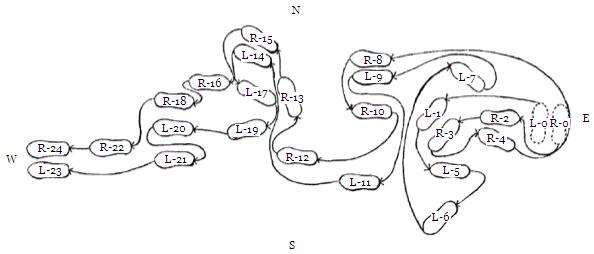
第一步……右足與左足並立
Stance 1: Right 0, Left 0 – feet together [Posture 1]
第二步……左一與右二作點步
Stance 2: Left 1, Right 2 – pointed stance [Posture 2]
第三步……右三與左一並立
Stance 3: Right 3, Left 1 – feet together [Posture 3]
第四步……右四與左五作點步
Stance 4: Right 4, Left 5 – pointed stance [Posture 4]
第五步……右四與左六作弓步
Stance 5: Right 4, Left 6 – bow stance [Posture 5]
第六步……右四與左七作拗步
Stance 6: Right 4, Left 7 – twisted stance [Posture 6]
第七步……左七與右八作弓步
Stance 7: Left 7, Right 8 – bow stance [Posture 7]
第八步……右八與左九並立
Stance 8: Right 8, Left 9 – feet together [Posture 8]
第九步……右十上點步左十與右十二作點步
Stance 9: Right 10 (advancing into pointed stance), Left 10 [11], Right 12 – pointed stance [Posture 9]
第十步……右十三走左十四上與右十五並立
Stance 10: Right 13 (walking step), Left 14 (advancing), Right 15 – feet together [Posture 10]
第十一步…右十六與左十七作點步
Stance 11: Right 16, Left 17 – pointed stance [Posture 11]
第十二步…右十八與左十九作點步
Stance 12: Right 18, Left 19 – pointed stance [Posture 12]
第十三步…右十八與左二十作點步
Stance 13: Right 18, Left 20 – pointed stance [feet together] [Posture 13]
第十四步…右二十二與左二十一作點步
Stance 14: Right 22, Left 21 – pointed stance [Posture 14]
第十五步…右二十二與左二十三作弓步
Stance 15: Right 22, Left 23 – bow stance [Posture 15]
第十六步…左二十三與右二十四並立
Stance 16: Left 23, Right 24 – feet together [Posture 16]
第二段(步法脚印自西而東)
SECTION 2 (stepping from west to east):


第一步……右一提起向東落步左三跳步右四上作馬步(騎馬式)
Stance 1: Right 1 (lift then come down to the east [Right 2]), Left 3 (jumping step), Right 4 (advancing) – horse-riding stance [Posture 17]
第二步……左五與右六並立
Stance 2: Left 5, Right 6 – feet together [Posture 18]
第三段(步法脚印自東而西)
SECTION 3 (stepping from east to west):


第一步……右一與左二作點步
Stance 1: Right 1, Left 2 – pointed stance [Posture 19]
第二步……左三與右四作馬步
Stance 2: Left 3, Right 4 – horse-riding stance [Posture 20]
第三步……右四左五作點步
Stance 3: Right 4, Left 5 – pointed stance [Postures 21-23]
第四步……右六左七右八作走步
Stance 4: Right 6, Left 7, Right 8 – walking steps [Posture 24&25 (three times)]
第五步……左九右十並立
Stance 5: Left 9, Right 10 – feet together [Posture 25 (as static posture)]
第四段(步法脚印自西而東)
SECTION 4 (stepping from west to east):

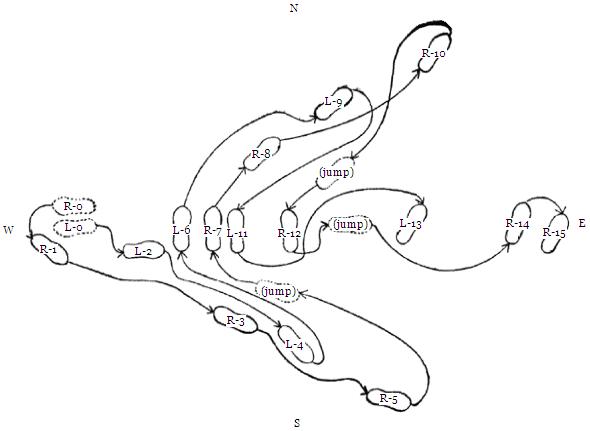
第一步……右二與左二作點步
Stance 1: Right 2 [1], Left 2 – pointed stance [Posture 26]
第二步……左二與右三作弓步
Stance 2: Left 2, Right 3 – bow stance [Posture 27]
第三跳步…左四與右五作弓步
Stance 3: Left 4, Right 5 – bow stance [Postures 28-30]
第四跳步…左六與右七作點步
Stance 4: Left 6, Right 7 – pointed stance [Postures 31&32]
第五步……左六與右八作弓步
Stance 5: Left 6, Right 8 – bow stance [Posture 33]
第六跳步…左九與右十作弓步
Stance 6: Left 9, Right 10 – bow stance [Postures 34-36]
第七跳步…左十一與右十二作點步
Stance 7: Left 11, Right 12 – pointed stance [Postures 37-39]
第八跳步…左十三與右十四作弓步
Stance 8: Left 13, Right 14 – bow stance [Posture 40]
第九步……右十五作獨立步
Stance 9: Right 15 – one-legged stance [Posture 41]
第五段(步法脚印自東而西)
SECTION 5 (stepping from east to west):


第一步……右一與左二作點步
Stance 1: Right 1, Left 2 – pointed stance [Posture 42]
第二步……左三與右四作點步
Stance 2: Left 3, Right 4 – pointed stance [Posture 43]
第三步……右四與左五作弓步
Stance 3: Right 4, Left 5 – bow stance [Posture 44]
第四步……左六與右七作點步
Stance 4: Left 6, Right 7 – pointed stance [Posture 45]
第五步……左八作獨立步
Stance 5: Left 8 – one-legged stance [Posture 46]
第六段(步法脚印自西而東)
SECTION 6 (stepping from west to east):
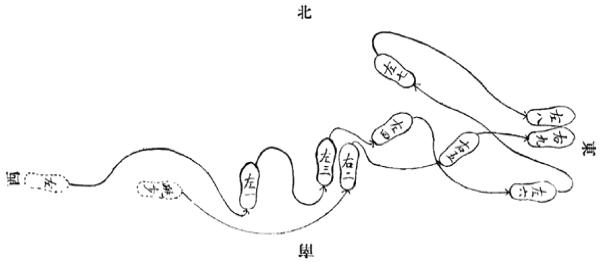
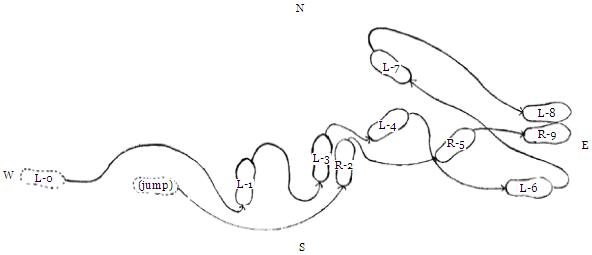
第一步……右跳左上左一與右二作馬步
Stance 1: Right jump with Left advance, Left 1, Right 2 – horse-riding stance [Posture 47]
第二步……右二與左三並立
Stance 2: Right 2, Left 3 – feet together [Posture 48]
第三步……左四與右五作弓步
Stance 3: Left 4, Right 5 – bow stance [Postures 49&50]
第四步……右五與左六作弓步
Stance 4: Right 5, Left 6 – bow stance [Posture 51]
第五步……左七與右五作弓步
Stance 5: Left 7, Right 5 – bow stance [Postures 52&53]
第六步……左八與右九並立
Stance 6: Left 8, Right 9 – feet together [Posture 54]
第七段(步法脚印自東而西)
SECTION 7 (stepping from east to west):


第一步……右一與左二作偸步
Stance 1: Right 1, Left 2 – stealth stance [Posture 55 (Left 2 also for one-legged Posture 57]
第二步……右三與左四作偸步
Stance 2: Right 3, Left 4 – stealth stance [Posture 56]
第三步……右五與左六作走步
Stance 3: Right 5, Left 6 – walking steps [Posture 58]
第四步……左六與右七作偸步
Stance 4: Left 6, Right 7 – stealth stance [Posture 58 cont.]
第五步……左六與右八作馬步
Stance 5: Left 6, Right 8 – horse-riding stance [Posture 58 cont.]
第六步……右九作獨立步
Stance 6: Right 9 – one-legged stance [Posture 59]
第八段(步法脚印自西而東)
SECTION 8 (stepping from west to east):


第一步……右一與左二作弓步
Stance 1: Right 1, Left 2 – bow stance [Postures 60&61]
第二步……右一與左三作點步
Stance 2: Right 1, Left 3 – pointed stance [Posture 62]
第三步……左三與右四作拗步
Stance 3: Left 3, Right 4 – twisted stance [Posture 62 cont.]
第四步……右四與左五作拗步
Stance 4: Right 4, Left 5 – twisted stance [Posture 63]
第五步……左五與右六作弓步
Stance 5: Left 5, Right 6 – bow stance [Posture 63 cont.]
第六步……右六與左七作點步
Stance 6: Right 6, Left 7 – pointed stance [Posture 64]
第七步……右八與左九作走步
Stance 7: Right 8, Left 9 – walking steps [Postures 65&66]
第八步……右十與左十一作偸步
Stance 8: Right 10, Left 11 – stealth stance [Posture 67]
第九步……左十一與右十二作馬步
Stance 9: Left 11, Right 12 – horse-riding stance [Posture 68]
第十步……左十三與右十四作馬步
Stance 10: Left 13, Right 14 – horse-riding stance [Posture 68 cont.]
第九段(步法脚印自東而西)
SECTION 9 (stepping from east to west):


第一步……右一與左二作弓步
Stance 1: Right 1, Left 2 – bow stance [Postures 69&70]
第二步……右一與左三作點步
Stance 2: Right 1, Left 3 – pointed stance [Posture 71]
第三步……右四左五與右六作走步
Stance 3: Right 4, Left 5, Right 6 – walking steps [Posture 72]
第四步……左七與右八並立
Stance 4: Left 7, Right 8 – feet together [Posture 72 cont.]
第十段(步法脚印自西而東)
SECTION 10 (stepping from west to east):


第一步……右一與左二作點步
Stance 1: Right 1, Left 2 – pointed stance [Posture 73 (Left 2 for one-legged Posture 74)]
第二步……右三跳左四與右五作弓步
Stance 2: Right 3 (jumping), Left 4, Right 5 – bow stance [Postures 75]
第三步……左六與右七作馬步
Stance 3: Left 6, Right 7 – horse-riding stance [Posture 76]
第四步……右七與左八作點步
Stance 4: Right 7, Left 8 – pointed stance [Posture 77]
-
第一式 迎門獻劍
POSTURE 1: PRESENTING THE SWORD BEFORE THE GATE

謌曰
Lyrics:
敵人來刺我的臂
橫劍截腕向西退
An opponent attacks with a stab to my arm.
I use TAKING THE SWORD ACROSS TO CHECK HIS WRIST while retreating to the west.
據場之東面向北出式。兩足並立。左手握拳。右手持劍橫於腰前,兩刃上下,劍鋒與面俱向西。是為迎門獻劍。此式分上中下三招:上用望巧雲。中用橫劍截腕。下用夜叉探海。如敵人來刺右臂,則左足向西撤半步,身隨劍轉向東面,右足在前作點步,橫劍截敵人外腕。其姿式如下:
I begin in the east, facing to the north, feet together. My left hand is grasped into a fist, right hand holding my sword horizontal in front of my waist, the edges up and down. The sword tip and my face are both facing to the west. This is PRESENTING THE SWORD BEFORE THE GATE.
(Techniques that follow from it for each of the three levels – high, middle, low – could be: high – GAZING UPON BEAUTIFUL CLOUDS, middle – TAKING THE SWORD ACROSS TO CHECK HIS WRIST, low – NIGHT DEMON SEARCHES THE SEA.)
If the opponent attacks with a stab to my right arm, my left leg withdraws a half step to the west, my torso goes along with my sword as it turns to point to the east, my right leg now forward making a pointed stance as my sword goes across with a checking technique to the outside of his wrist. This posture is as in the photo below:
第二式 橫劍截腕
POSTURE 2: TAKING THE SWORD ACROSS TO CHECK HIS WRIST

謌曰
Lyrics:
敵人來刺我的膝
蜻蜓點水向下滴
The opponent attacks with a stab to my knee.
I use DRAGONFLY SKIMS THE WATER to drop downward.
此式面向正東。右手持劍,劍鋒斜向上方,略高於頭頂。劍脊正對面部,用劍截取敵人之外腕。左手揑劍訣罩於頭之前上方,是為橫劍截腕。此式分上中下三招:上用烏鵲飛空。中用蜻蜓點水。下用淵明折菊。如敵人來刺膝部,則右足退後與左足並立,劍鋒下點敵腕。同時左手副腕。其姿式如下。
The posture is now facing to the east. My right hand is holding my sword, the tip pointing diagonally upward, slightly higher than my headtop, the spine of the sword directly in front of my face. I am using my sword to perform a checking technique to the outside of the opponent’s wrist, while my left hand, formed as a swordsman’s hex, is placed in front of and above my head. This is TAKING THE SWORD ACROSS TO CHECK HIS WRIST.
(Techniques that follow from it for each of the three levels could be: high – MAGPIES FLY INTO THE SKY, middle – DRAGONFLY SKIMS THE WATER, low – TAO YUANMING PLUCKS A CHRYSANTHEMUM.)
If the opponent attacks with a stab to my knee, my right foot retreats to stand next to my left foot and my sword tip goes downward with a tapping technique to his wrist, my left hand assisting at my right wrist. This posture is as in the photo below:
第三式 蜻蜓點水
POSTURE 3: DRAGONFLY SKIMS THE WATER

謌曰
Lyrics:
敵人若從後面來
伏虎待敵莫徘徊
If an opponent attacks from behind,
I use CROUCHING TIGER POSTURE to await him without wavering.
此式面向正東。兩足並立。右手持劍,向下作點式。左手副腕。劍向下之斜度愈大愈好。是為蜻蜓點水。此式分上中下三招:上用平地挿香。中用伏虎式。下用珠簾倒捲。如敵人從後面來。則右足向東撤坐步。左足在前作點步。身隨劍轉。面向正西。作伏虎式以待敵。其姿式如下。
The posture is now facing to the east, feet together. My right hand is sending my sword downward with a tapping technique, the more diagonally downward the better, my left hand assisting at my right wrist. This is DRAGONFLY SKIMS THE WATER.
(Techniques that follow from it for each of the three levels could be: high – INSERTING A STICK OF INCENSE INTO LEVEL GROUND, middle – CROUCHING TIGER POSTURE, low – BEADED CURTAIN IS ROLLED AWAY.)
If an opponent attacks from behind, my right leg withdraws to the east and I sit, my left leg forward making a pointed stance, while my body turns along with my sword so that I am facing west, and I make the CROUCHING TIGER POSTURE to await him. This posture is as in the photo below:
第四式 伏虎式
POSTURE 4: CROUCHING TIGER POSTURE
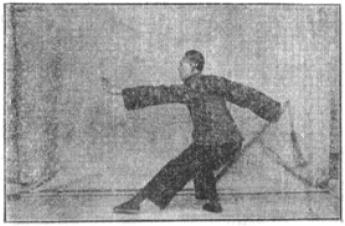
謌曰
Lyrics:
敵人來刺我左腕
仙人指路刺胸前
The opponent attacks with a stab to my left wrist.
I use IMMORTAL POINTS THE WAY to stab to his chest.
此式面向正西。右手持劍,劍鋒下垂,微向前斜,預備發手。左手揑劍訣正對面部。左足在前作點步。是為伏虎式。此式分上中下三招:上用順風領衣。中用仙人指路。下用海底撈月。如敵人來刺左腕。則左手撤回,左足向西南上弓步。同時劍向前平刺敵人之胸。其姿式如下:
The posture is now facing to the west. My right hand is holding my sword, the tip hanging down and slanted slightly forward, prepared to be thrust out. My left hand, formed as a swordsman’s hex, is directly in front of my face. My left leg is forward making a pointed stance. This is CROUCHING TIGER POSTURE.
(Techniques that follow from it for each of the three levels could be: high – WIND TUGS AT THE ROBE, middle – IMMORTAL POINTS THE WAY, low – TRYING TO SCOOP THE MOON’S REFLECTION FROM THE WATER.)
If the opponent attacks with a stab to my left wrist, I withdraw my left hand and step my left leg forward into a bow stance toward the southwest. At the same time, I send my sword forward with a level stab to his chest. This posture is as in the photo below:
第五式 仙人指路
POSTURE 5: IMMORTAL POINTS THE WAY
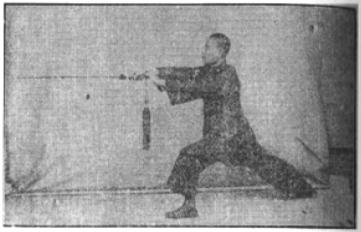
謌曰
Lyrics:
敵人來刺我左肩
漁郎問津托刁連
The opponent attacks with a stab to my left shoulder.
I use FISHERMAN EXAMINES FOR WHERE TO CROSS THE RIVER to prop up continuing into hooking away.
此式面向西南。兩足作弓步。右手持劍向前平刺。左手副腕。是為仙人指路。此式分上中下三招:上用白鶴展翅。中用漁郎問津。下用海底撈月。如敵人刺我左肩,則用劍向上托敵腕。敵人回刺,再向下刁腕。同時身隨劍轉,斜身拗步,劍與手分。垂於兩肋下,預備向前平刺,其姿式如下。
The posture is now facing to the southwest, my legs making a bow stance. My right hand sends my sword forward in a level stab, my left hand assisting at my right wrist. This is IMMORTAL POINTS THE WAY.
(Techniques that follow from it for each of the three levels could be: high – WHITE CRANE SPREADS ITS WINGS, middle – FISHERMAN EXAMINES FOR WHERE TO CROSS THE RIVER, low – TRYING TO SCOOP THE MOON’S REFLECTION FROM THE WATER.)
If the opponent attacks with a stab to my left shoulder, I send my sword upward with a propping technique to his wrist. He retracts his stab, so I send my sword downward to his wrist with a hooking technique, my torso at the same time turning along with my sword. With my torso slanting and my stance twisting, my sword and left hand spread apart to be hanging down below my ribs on either side, ready to go forward with a level stab. This posture is as in the photo below:
第六式 漁郎問津(一)
POSTURE 6: FISHERMAN EXAMINES FOR WHERE TO CROSS THE RIVER – Part 1
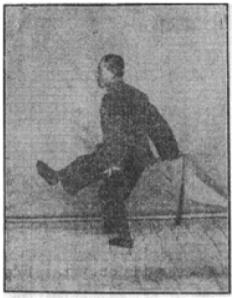
謌曰
Lyrics:
敵人來刺我左肋
漁郎問津擰身退
The opponent attacks with a stab to my left ribs.
I use FISHERMAN EXAMINES FOR WHERE TO CROSS THE RIVER to twist my torso while retreating.
此式面向西南。身向西北。右足曲立。左足提向右前方。斜身拗步。左手揑劍訣。右手持劍作平刺之預備式。恰如漁郎問津之狀。是為漁郎問津第一動作。如敵人來刺左肋,則左足落地,右足向西上弓步,身隨劍向前刺敵人前胸。同時左手副腕。其姿式如下。
The posture is now facing to the southwest, torso squared to the northwest. My right leg is standing bent, my left leg lifted to the forward right. My torso is slanted, my stance twisted. My left hand is formed as a swordsman’s hex and my right hand is holding my sword in readiness to make a level stab. It is the appearance of a fisherman examining for where to cross the river. This is the first movement of FISHERMAN EXAMINES FOR WHERE TO CROSS THE RIVER.
If the opponent attacks with a stab to my left ribs, my left leg comes down, my right leg steps forward to the west into a bow stance, and my torso goes along with my sword as it stabs forward to his chest, my left hand assisting at my right wrist. This posture is as in the photo below:
第七式 漁郎問津(二)
POSTURE 7: FISHERMAN EXAMINES FOR WHERE TO CROSS THE RIVER – Part 2
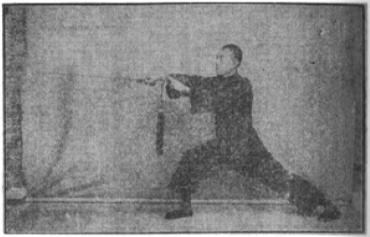
謌曰
Lyrics:
敵人來刺我右肩
白鶴亮翅向後翻
The opponent attacks with a stab to my right shoulder.
I use WHITE CRANE SHOWS ITS WINGS to turn over to the rear.
此式面向西南。右手向前刺平劍。左手副腕。右足在前作弓步。是為漁郎問津定式。此式分上中下三招:上用白鶴亮翅。中用順風領衣。下用劍刺三里。如敵人來刺右肩。則右足向前斜上一步,左足隨與右足並立。兩臂同時舒平,劍向後閃。其姿式如下。
The posture is now facing to the southwest. My right hand is sending my sword forward with a level stab, my left hand assisting at my right wrist. My right leg is forward making a bow stance. This is the freeze-frame posture of FISHERMAN EXAMINES FOR WHERE TO CROSS THE RIVER [unlike Part 1 which does not pause in a pose].
(Techniques that follow from it for each of the three levels could be: high – WHITE CRANE SHOWS ITS WINGS, middle – WIND TUGS AT THE ROBE, low – SWORD STABS THE LENGTH OF A MILE.)
If the opponent attacks with a stab to my right shoulder, my right leg steps diagonally forward and my left foot follows forward to stand next to my right foot, while my arms spread horizontally, my sword flashing to the rear. This posture is as in the photo below:
第八式 白鶴亮翅
POSTURE 8: WHITE CRANE SHOWS ITS WINGS
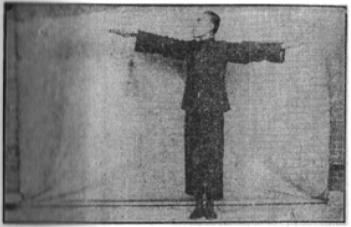
謌曰
Lyrics:
敵人來刺我的腿
金針入地劍下隨
The opponent attacks with a stab to my leg.
I use GOLDEN NEEDLE INTO THE GROUND to follow it downward.
此式面向西南。右手持劍。微向後閃,劍身平直。左手揑劍訣舒平與右手對稱。二足並立。是為白鶴亮翅。此式分上中下三招:上用力劈華山。中用藤蘿掛壁。下用金針入地。如敵人來刺我右腿。則右足向前上步,劍隨式向後下方作點式。稍停,左足向南跳步,同時右手持劍,向上冲,復向左下方刺下。左手副腕。其姿式如下。
The posture is now facing to the southwest. My right hand sends my sword flashing slightly to the rear, the sword body flat and straight. My left hand, formed as a swordsman’s hex, is extended level with my right hand. My feet are together. This is WHITE CRANE SHOWS ITS WINGS.
(Techniques that follow from it for each of the three levels could be: high – POWERFUL CHOP THROUGH MT. HUA, middle – VINES CLIMBING THE WALL, low – GOLDEN NEEDLE INTO THE GROUND.)
If the opponent attacks with a stab to my right thigh, my right leg steps forward while my sword follows the posture downward with a tapping technique. There is a slight pause, then my left leg jumps to the south [and my right leg follows to make a pointed stance]. At the same time, my right hand sends my sword rushing through upward [coordinated with my left leg], then stabbing downward to the lower left [coordinated with my right leg], my left hand assisting at my right wrist. This posture is as in the photo below:
第九式 金針入地
POSTURE 9: GOLDEN NEEDLE INTO THE GROUND
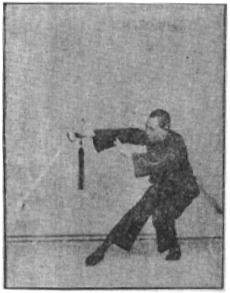
謌曰
Lyrics:
敵人來刺我右肩
力劈華山莫遲延
The opponent attacks with a stab to my right shoulder.
I perform POWERFUL CHOP THROUGH MT. HUA without delay.
此式面向正西。右手持劍,劍鋒向下。左手副腕。右足在前作點步。是為金針入地。此式分上中下三招:上用力劈華山。中用摘星換月。下用快馬加鞭。如敵人來刺我右肩。則右足向西北上步,左足向前,與右足並立。右手用劍劈敵人之上腕。其姿式如下。
The posture is now facing to the west. My right hand is holding my sword, the tip pointing downward, my left hand assisting at my right wrist. My right leg is forward making a pointed stance. This is GOLDEN NEEDLE INTO THE GROUND.
(Techniques that follow from it for each of the three levels could be: high – POWERFUL CHOP THROUGH MT. HUA, middle – PLUCK AWAY THE STARS & REPLACE THEM WITH THE MOON, low – QUICKEN THE HORSE WITH MORE WHIPPING.)
If the opponent attacks with a stab to my right shoulder, my right leg steps forward to the northwest, my left foot goes forward to stand next to my right foot, and my right hand uses my sword to perform a chopping technique onto his wrist. This posture is as in the photo below:
第十式 力劈華山
POSTURE 10: POWERFUL CHOP THROUGH MT. HUA
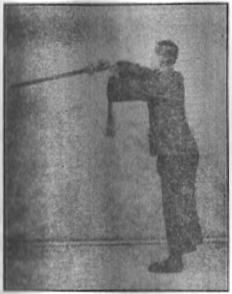
謌曰
Lyrics:
敵人從後襲我背
珠簾倒捲轉身揮
An opponent makes a surprise attack from behind.
I use BEADED CURTAIN IS ROLLED AWAY to turn around and wipe him away.
此式面向西北。右手持劍,向前作點式。左手劍訣罩於頂前。二足並立。是為力劈華山。此式分上中下三招:上用白鶴亮翅。中用珠簾倒捲。下用海底撈月。如敵人在後刺下劍。則右足向前上半步,身隨劍由左方轉回。反截敵人之腕,同時左足向後拉作點步,左手副腕,其姿式如下。
The posture is now facing to the northwest. My right hand is sending my sword forward with a tapping technique. My left hand as a swordsman’s hex is placed in front of my forehead [although the photo shows it at the wrist]. My feet are together. This is POWERFUL CHOP THROUGH MT. HUA.
(Techniques that follow from it for each of the three levels could be: high – WHITE CRANE SHOWS ITS WINGS, middle – BEADED CURTAIN IS ROLLED AWAY, low – TRYING TO SCOOP THE MOON’S REFLECTION FROM THE WATER.)
If an opponent comes from behind with a low stab, my right leg takes a half step forward, my body goes along with my sword by turning around to the left for it to oppose him with a checking technique to his wrist, my left hand assisting at my right wrist, while my left leg pulls back to make a pointed stance. This posture is as in the photo below:
第十一式 珠簾倒捲(一)
POSTURE 11: BEADED CURTAIN IS ROLLED AWAY – Part 1
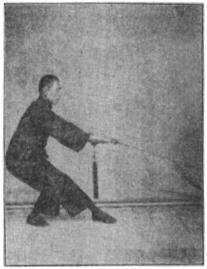
謌曰
Lyrics:
敵人來刺我的面
珠簾倒捲托刁腕
The opponent attacks with a stab to my face.
I use BEADED CURTAIN IS ROLLED AWAY to prop then hook to his wrist.
此式面向正東。右手持劍,劍鋒微向前下方。劍刃左右向。左手副腕。身略向前俯。左足在前作點步。是為珠簾倒捲第一動作。此式分上中下三招:上用望巧雲。中用珠簾倒捲。下用千斤墜地。如敵人來刺面部,並回劍連刺中下二劍。則我上托,中刁,下截敵人之腕。此三劍相連,最明顯之着法。用刁之時,左足向後撤,作退跳之步,式定而下截之劍隨即發出。此式內外並用,故第二動作,與此定式相同。
The posture is now facing to the east. My right hand is holding my sword, the tip slightly lowered forward, edges to the left and right, my left hand assisting at my right wrist. My torso is slightly leaning forward. My left leg is forward making a pointed stance. This is the first movement of BEADED CURTAIN IS ROLLED AWAY.
(Techniques that follow from it for each of the three levels could be: high – GAZING UPON BEAUTIFUL CLOUDS, middle – BEADED CURTAIN IS ROLLED AWAY, low – A THOUSAND POUNDS DROP TO THE GROUND.)
If the opponent attacks with a stab to my face, drawing it back to continue with stabs to the middle and below, I use a propping technique against the high stab, a hooking technique against the middle stab, and a checking technique to his wrist to counter the low stab. These three actions are continuous and are very obvious techniques. During the hooking technique, my left leg jumps back a step, then once the posture settles [after also stepping back my right leg so my left is making the pointed stance], the same downward check immediately comes out. This posture has techniques that move both inward and outward, and this is thus the second movement, but it ends up in the same posture as before.
第十二式 珠簾倒捲(二)
POSTURE 12: BEADED CURTAIN IS ROLLED AWAY – Part 2
謌曰
Lyrics:
敵人來刺我左臂
千斤墜地向右退
The opponent attacks with a stab to my left shoulder.
I use A THOUSAND POUNDS DROP TO THE GROUND to retreat to the right.
此式與前同,故從畧。此式亦可用下三招:上用祥雲捧日。中用珠簾倒捲。下用葉底藏花。如敵人由後面來刺左臂。則身隨劍向右後轉,橫截敵人之腕。用時左足與右足並立,劍鋒向上直立。左手揑劍訣罩於頭頂。其姿式如下。
The posture is as before and so is not described again here.
(Techniques that follow from it for each of the three levels could be: high – PROPITIOUS CLOUDS CARRY THE SUN [A THOUSAND POUNDS DROP TO THE GROUND], middle – BEADED CURTAIN IS ROLLED AWAY, low – FLOWER HIDDEN UNDER THE LEAF.)
If an opponent attacks from behind with a stab to my left arm, my body goes along with my sword, turning around to the right rear as it goes across with a checking technique to his wrist, my left foot moving to stand next to my right foot. The sword tip is pointing straight up, my left hand formed as a swordsman’s hex placed over my headtop. This posture is as in the photo below:
第十三式 千斤墜地(一)
POSTURE 13: A THOUSAND POUNDS DROP TO THE GROUND – Part 1
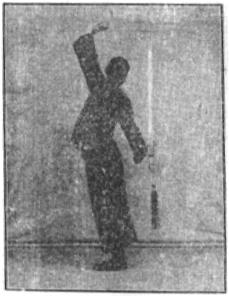
謌曰
Lyrics:
敵人來托我的腕
千斤墜地向左翻
The opponent attacks with a propping technique to my wrist.
I use A THOUSAND POUNDS DROP TO THE GROUND to turn over to the left.
此式面向正西。右手持劍,劍鋒向上直立。左手劍訣罩於頂上。二足並立。上半身向右後方傾側,是為千斤墜地第一動作。此式分上中下三招:上用順風領衣。中用走馬回頭。下用千斤墜地。如敵人托我底腕。則右手持劍向前收攏,同時左足向左跳,右足跟作點步。左手副腕。其姿式如下。
The posture is now facing to the west. My right hand is holding my sword, the tip pointing straight up, my left hand as a swordsman’s hex placed above my headtop. My feet are together, my upper body leaning to the right rear. This is the first movement of A THOUSAND POUNDS DROP TO THE GROUND.
(Techniques that follow from it for each of the three levels could be: high – WIND TUGS AT THE ROBE, middle – RUNNING HORSE LOOKS BEHIND, low – A THOUSAND POUNDS DROP TO THE GROUND.)
If the opponent does a propping technique under my wrist, my right hand gathers my sword forward, my left hand assisting at my right wrist, while my left leg jumps to the left and my right leg follows to make a pointed stance. This posture is as in the photo below:
第十四式 千斤墜地(二)
POSTURE 14: A THOUSAND POUNDS DROP TO THE GROUND – Part 2
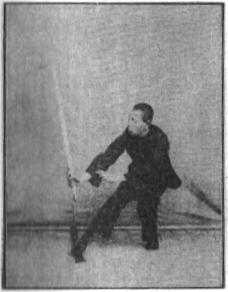
謌曰
Lyrics:
敵人來刺我右肩
抹式副手攻向前
The opponent attacks with a stab to my right shoulder.
I use SMEARING TECHNIQUE WITH ASSISTING HAND to attack forward.
此式面向正西。右手持劍,劍鋒向上直立。左手副腕。右足在前作點步。是為千斤墜地第二動作。此式分上中下三招:上用烏鵲飛空。中用浩然折梅。下用千斤墜地。如敵人來刺右肩。則身隨劍向前,用抹式。橫劍掃壓敵人之腕,同時左足向前上弓步。左手副腕。其姿式如下。
The posture is now facing to the west. My right hand is holding my sword, the tip pointing straight up, my left hand assisting at my right wrist. My right leg is forward making a pointed stance. This is the second movement of A THOUSAND POUNDS DROP TO THE GROUND.
(Techniques that follow from it for each of the three levels could be: high – MAGPIES FLY INTO THE SKY [SMEARING TECHNIQUE WITH ASSISTING HAND], middle – MENG HAORAN PLUCKS A PLUM, low – A THOUSAND POUNDS DROP TO THE GROUND.)
If the opponent attacks with a stab to my right shoulder, my torso goes along with my sword as it moves forward performing a smearing technique, sweeping across and pressing down on his wrist, my left hand assisting at my right wrist, while my left leg steps forward into a bow stance. This posture is as in the photo below:
第十五式 抹式副手
POSTURE 15: SMEARING TECHNIQUE WITH ASSISTING HAND
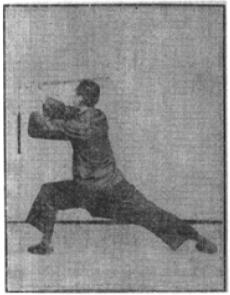
謌曰
Lyrics:
敵人來刺我的胸
祥雲捧日刁抹行
The opponent attacks with a stab to my chest.
I use PROPITIOUS CLOUDS CARRY THE SUN to hook and smear.
此式面向正西。右手持劍,向前平壓敵人之腕。左手副腕。左足在前作弓步。是為抹式副手。此式分上中下三招:上用平地挿香。中用祥雲捧日。下用夜叉探海。如敵人來刺胸前。身微後仰,用刁法取敵人之腕。敵人再刺,則用捧劍。右足與左足並立。其姿式如下。
The posture is now facing to the west. My right hand is holding my sword, which is level in front of me pushing down on the opponent’s wrist, my left hand assisting at my right wrist. My left leg is forward making a bow stance. This is SMEARING TECHNIQUE WITH ASSISTING HAND.
(Techniques that follow from it for each of the three levels could be: high – INSERTING A STICK OF INCENSE INTO LEVEL GROUND, middle – PROPITIOUS CLOUDS CARRY THE SUN, low – NIGHT DEMON SEARCHES THE SEA.)
If the opponent attacks with a stab to my chest, my torso slightly leans back as I use a hooking technique to catch his wrist. He stabs again, so I use a carrying technique as my right foot moves to stand next to my left foot. This posture is as in the photo below:
第十六式 祥雲捧日
POSTURE 16: PROPITIOUS CLOUDS CARRY THE SUN
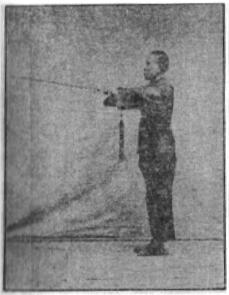
謌曰
Lyrics:
敵人從後刺我背
仙人入洞旋轉追
The opponent attacks with a stab to my back.
I use IMMORTAL GOES INTO HIS CAVE to whirl around and chase him.
此式面向正西。右手持劍,捧之使平。劍鋒向前,左手副腕。二足並立。是為祥雲捧日。此式分上中下三招:上用力劈華山。中用仙人入洞,下用葉底藏花。如敵人來刺我背。則右手提劍作刁式。右足提起,轉身隨劍向右旋轉。右足落地。左足再向前作跳步,轉身作騎馬式。當左足跳時,同時左手由下畫圈,揑劍訣罩於頂前。其姿式如下。
The posture is now facing to the west. My right hand is holding my sword, performing a level carrying technique, the tip pointing forward, my left hand assisting at my right wrist. My feet are together. This is PROPITIOUS CLOUDS CARRY THE SUN.
(Techniques that follow from it for each of the three levels could be: high – POWERFUL CHOP THROUGH MT. HUA, middle – IMMORTAL GOES INTO HIS CAVE, low – FLOWER HIDDEN UNDER THE LEAF.)
If the opponent attacks with a stab to my back, my right hand lifts my sword to perform a hooking technique as my right leg lifts and my body turns to the right along with my sword. When my right leg comes down, my left leg then does a jumping step forward, my body turns around another turn [as my right leg advances] to make a horse-riding stance. While my left leg is jumping, my left hand draws a circle from below which will finally arrive as a swordsman’s hex in front of my headtop. This posture is as in the photo below:
第十七式 仙人入洞
POSTURE 17: IMMORTAL GOES INTO HIS CAVE
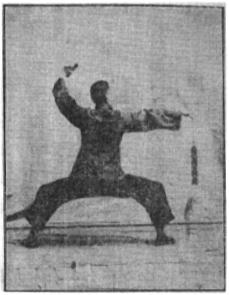
謌曰
Lyrics:
敵人來截我的腕
蜻蜓點水莫遲延
The opponent attacks with a checking technique to my wrist.
I perform DRAGONFLY SKIMS THE WATER without delay.
此式面向東,身向北。右手持劍,劍身橫平,劍鋒向北。劍與右臂作直角。左手劍訣罩於頂前。二足作騎馬式。是為仙人入洞,此式分上中下三招:上用封侯掛印。中用蜻蜓點水,下用靈貓捕鼠。如敵人由外截我腕。則將劍平撤,隨式下點。同時左手副腕,左足向前與右足並立。其姿式與第三式同。
The posture is now facing to the east, torso squared to the north. My right hand is holding my sword, the sword body level, tip pointing to the north. My sword and my right arm are making a triangle [from tip to shoulder to hand to tip]. My left hand as a swordsman’s hex is placed in front of my headtop. My legs are making a horse-riding stance. This is IMMORTAL GOES INTO HIS CAVE.
(Techniques that follow from it for each of the three levels could be: high – NOBLEMAN HANGS UP HIS SEAL, middle – DRAGONFLY SKIMS THE WATER, low – QUICK CAT CATCHES THE MOUSE.)
If the opponent attacks with a checking technique to the outside of my wrist, I withdraw my sword horizontally, then follow the posture downward with a tapping technique, my left hand assisting at my right wrist, while my left foot goes forward to stand next to my right foot. This posture is the same as in Posture 3.
第十八式 蜻蜓點水
POSTURE 18: DRAGONFLY SKIMS THE WATER
謌曰
Lyrics:
敵人若從西面返
伏虎式上窺機變
If an opponent counterattacks from the west,
I use CROUCHING TIGER POSTURE to watch for an opportunity.
此式見前,茲從畧。副下變三招:上用黃龍翻身。中用伏虎式。下用群鴻戲海如敵人由西反攻,則作伏虎式以待之。其姿式與第四式同。
This posture is as before and so its description is not repeated here.
(Techniques that follow from it for each of the three levels could be: high – YELLOW DRAGON TURNS AROUND, middle – CROUCHING TIGER POSTURE, low – FLOCK OF GEESE GOING OVER THE SEA.)
If the opponent counterattacks from the west, I make the CROUCHING TIGER POSTURE to await what he will do next. This posture is the same as in Posture 4.
第十九式 伏虎式
POSTURE 19: CROUCHING TIGER POSTURE
謌曰
Lyrics:
敵人來刺我的面
氷箸垂簷托底腕
The opponent attacks with a stab to my face.
I use ICICLE HANGING FROM THE EAVES to prop under his wrist.
伏虎式見前。此式上劍亦可用氷箸埀簷。如敵人來刺面部。則用劍向上托敵底腕,隨即抽回自上而下畫作圓形。同時身隨劍上步,右手持劍復自左劃半圓形,隨足作騎馬式。其姿式如下。
CROUCHING TIGER POSTURE is as before, but this time can be followed by ICICLE HANGING FROM THE EAVES.
If the opponent attacks with a stab to my face, I send my sword up with a propping technique under his wrist, then draw a circle from above to below while my body goes along with my sword by advancing [left leg then right leg]. My right hand is arcing my sword through the rest of the circle from my left side as my legs make a horse-riding stance. This posture is as in the photo below:
第二十式 氷箸垂簷
POSTURE 20: ICICLE HANGS FROM THE EAVES
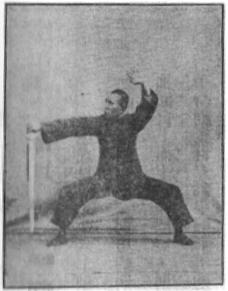
謌曰
Lyrics:
敵人來刺我左肩
內提金爐得占先
The opponent attacks with a stab to my left shoulder.
I use INWARD SPARKING-THE-GOLDEN-FURNACE to get in first.
此式面向正南。右手持劍,劍鋒下埀。左手劍訣罩於頂前。兩足作騎馬式。是為氷箸垂簷。此式分上中下三招:上用烏鵲飛空。中用內提金爐。下用快馬加鞭。如敵人來刺左肩。則身隨劍向左托敵底腕,右足隨劍向東提起。其姿式如下。
The posture is now facing to the south. My right hand is holding my sword, the tip hanging down. My left hand as a swordsman’s hex is placed in front of my headtop. My legs are making a horse-riding stance. This is ICICLE HANGING FROM THE EAVES.
(Techniques that follow from it for each of the three levels could be: high – MAGPIES FLY INTO THE SKY, middle – INWARD SPARKING-THE-GOLDEN-FURNACE, low – QUICKEN THE HORSE WITH MORE WHIPPING.)
If the opponent attacks with a stab to my left shoulder, my body goes along with my sword as it goes to the left with a propping technique under his wrist, and my right leg goes along with my sword by lifting to the east. This posture is as in the photo below:
第二十一式 內提金爐
POSTURE 21: INWARD SPARKING-THE-GOLDEN-FURNACE

謌曰
Lyrics:
敵人在後刺我腰
外提金爐掛托挑
An opponent behind me stabs to my waist.
I use OUTWARD SPARKING-THE-GOLDEN-FURNACE to hang, prop, or lift.
此式面向正東。右手持劍托中平式。劍鋒向前。左手副腕。右足在前提起。左足直立。是為內提金爐。此式分上中下三招:上用打落金錢。中用外提金爐。下用遮前擋後。如敵人在後來刺腰部。則劍向後由下挑取敵人之腕。同時右足隨劍向西轉,左手副腕。其姿式如下。
The posture is now facing to the east. My right hand is holding my sword, performing a level propping technique, the tip pointing forward, my left hand assisting at my right wrist. My right leg is lifted in front, my left leg standing straight [bent]. This is INWARD SPARKING-THE-GOLDEN-FURNACE.
(Techniques that follow from it for each of the three levels could be: high – SLAMMING DOWN MONEY, middle – OUTWARD SPARKING-THE-GOLDEN-FURNACE, low – COVER IN FRONT & BLOCK BEHIND.)
If an opponent attacks from behind with a stab to my waist, my sword goes to the rear with a lifting technique from below to catch his wrist, my left hand assisting at my right wrist, while my right leg [comes down and] goes along with my sword as it turns around [to the left] to face to the west [and my left leg lifts]. This posture is as in the photo below:
第二十二式 外提金爐
POSTURE 22: OUTWARD SPARKING-THE-GOLDEN-FURNACE

謌曰
Lyrics:
敵人來刺我的面
金鷄點頭往上翻
The opponent attacks with a stab to my face.
I use GOLDEN ROOSTER PECKS WITH ITS HEAD to turn over upward.
此式面向正西。右手持劍,劍鋒向前。左手副腕。左足在前提起。右足在後直立。是為外提金爐。此式分上中下三招:上用白鶴亮翅。中用金雞點頭。下用金針入地。如敵人來刺面部。則用劍鋒上掛敵腕。左手副腕。同時左足落地。其姿式如下。
The posture is now facing to the west. My right hand is holding my sword, the tip pointing forward, my left hand assisting at my right wrist. My left leg is lifted in front, my right leg standing straight [bent] behind. This is OUTWARD SPARKING-THE-GOLDEN-FURNACE.
(Techniques that follow from it for each of the three levels could be: high – WHITE CRANE SHOWS ITS WINGS, middle – GOLDEN ROOSTER PECKS WITH ITS HEAD, low – GOLDEN NEEDLE INTO THE GROUND.)
If the opponent attacks with a stab to my face, I send my sword tip upward with a hanging technique to his wrist, my left hand assisting at my right wrist. At the same time, my left leg comes down. This posture is as in the photo below:
第二十三式 金鷄點頭(一)
POSTURE 23: GOLDEN ROOSTER PECKS WITH ITS HEAD – Part 1

謌曰
Lyrics:
敵人來刺我中盤
金鷄點頭往下翻
The opponent attacks with a stab to my midsection.
I use GOLDEN ROOSTER PECKS WITH ITS HEAD to turn over downward.
此式面向正西。右手持劍,劍鋒向上斜立。左手副腕。左足在前作點步。此式隨走隨點。是為金雞點頭第一動作。此式分上中下三招:上用金雞點頭。中用金雞點頭。下用千斤墜地。如敵人來刺胸部,則用劍下點敵人之腕。同時左足落實,右足隨起左手副腕。其姿式如下。
The posture is now facing to the west. My right hand is holding my sword so the tip is pointing diagonally upward, my left hand assisting at my right wrist. My left leg is forward making a pointed stance. With the step that follows, there is a tapping technique that happens with it. This is the first movement of GOLDEN ROOSTER PECKS WITH ITS HEAD.
(Techniques that follow from it for each of the three levels could be: high – GOLDEN ROOSTER PECKS WITH ITS HEAD, middle – GOLDEN ROOSTER PECKS WITH ITS HEAD, low – A THOUSAND POUNDS DROP TO THE GROUND.)
If the opponent attacks with a stab to my chest, I send my sword downward with a tapping technique to his wrist, my left hand assisting at my right wrist, while my left leg takes all the weight and my right leg lifts. This posture is as in the photo below:
第二十四式 金鷄點頭(二)
POSTURE 24: GOLDEN ROOSTER PECKS WITH ITS HEAD – Part 2

謌曰
Lyrics:
敵人來刺上下盤
金鷄點頭上下翻
The opponent attacks with stabs high and low.
I use GOLDEN ROOSTER PECKS WITH ITS HEAD to turn over upward and downward.
此式面向正西。右手持劍,作下點式,左手副腕。左足在前作追式。隨走隨用劍鋒挑點敵人之腕。是為金雞點頭。第二動作。此式分上中下三招:上用金鷄點頭。中用金雞點頭。下用靈貓捕鼠。如敵人由上面點下,則用劍鋒上掛敵腕。同時右足前與左足齊。其定式如下。
The posture is now facing to the west. My right hand is sending my sword downward with a tapping technique, my left hand assisting at my right wrist. My left leg is forward in a chasing posture, stepping along with the sword tip as it lifts and taps to the opponent’s wrist. This is the second movement of GOLDEN ROOSTER PECKS WITH ITS HEAD.
(Techniques that follow from it for each of the three levels could be: high – GOLDEN ROOSTER PECKS WITH ITS HEAD, middle – GOLDEN ROOSTER PECKS WITH ITS HEAD, low – QUICK CAT CATCHES THE MOUSE.)
If the opponent taps down from above, I send my sword tip upward with a hanging technique to his wrist. At the same time, my right foot goes forward to stand next to my left foot. This posture is as in the photo below:
第二十五式 金鷄點頭(三)
POSTURE 25: GOLDEN ROOSTER PECKS WITH ITS HEAD – Part 3

謌曰
Lyrics:
敵人隨式向後翻
伏虎式上隨之變
The opponent goes along with the posture and turns over to end up behind me.
I use CROUCHING TIGER POSTURE as before to follow his changes.
此式面向正西。右手持劍,劍鋒向上斜立。左手副腕。二足並立。是為金鷄點頭。第三動作。此式分上中下三招:上用祥雲捧日。中用伏虎式。下用夜叉探海。如敵人由左後方攻來。則右足向西撤半步,轉身作伏虎式以待敵。
附註:金鷄點頭,可連走三次,而後定式變着。
The posture is now facing to the west. My right hand is holding my sword, the tip pointing diagonally upward, my left hand assisting at my right wrist. My feet are together. This is the third movement of GOLDEN ROOSTER PECKS WITH ITS HEAD.
(Techniques that follow from it for each of the three levels could be: high – PROPITIOUS CLOUDS CARRY THE SUN, middle – CROUCHING TIGER POSTURE, low – NIGHT DEMON SEARCHES THE SEA.)
If an opponent attacks from the left rear, I then withdraw my right leg a half step to the west, turning around and making the CROUCHING TIGER POSTURE to await him.
Note: GOLDEN ROOSTER PECKS WITH ITS HEAD [Parts 1&2] can be performed continuously three times, switching to a static posture with the last one.
第二十六式 伏虎式
POSTURE 26: CROUCHING TIGER POSTURE
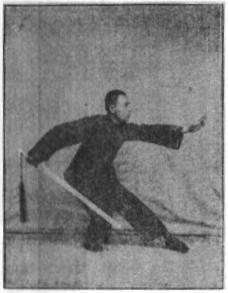
謌曰
Lyrics:
敵人來刺我胸前
黃龍擺尾托捲連
The opponent attacks with a stab to my chest.
I use YELLOW DRAGON SWINGS ITS TAIL to prop and roll.
此式面向東南。式與第四式同,存此圖以明持劍之姿態。此式分上中下三招:上用白馬分鬃。中用黃龍擺尾。下用羣鴻戱海。如敵來刺中平劍。則右足向前上弓步,用劍橫截敵人之裏腕。其姿式如下。
The posture is now facing to the southeast. It is the same as in Posture 4, but in this photo the grasping of the sword is more noticeable.
(Techniques that follow from it for each of the three levels could be: high – WHITE HORSE PARTS ITS MANE, middle – YELLOW DRAGON SWINGS ITS TAIL, low – FLOCK OF GEESE GOING OVER THE SEA.)
If the opponent attacks with a level stab, my right leg steps forward into a bow stance as I bring my sword across to do a checking technique to the inside of his wrist. This posture is as in the photo below:
第二十七式 黃龍擺尾(一)
POSTURE 27: YELLOW DRAGON SWINGS ITS TAIL – Part 1
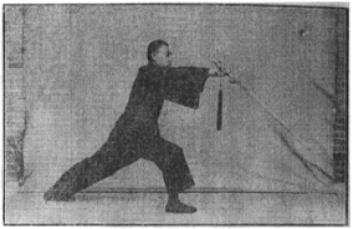
謌曰
Lyrics:
敵人來取我上盤
黃龍擺尾托捧還
The opponent attacks high.
I counter with YELLOW DRAGON SWINGS ITS TAIL to prop and carry.
此式面向東南。右手持劍,劍鋒斜垂向前下方。左手副腕。左足在前作弓步。是為黃龍擺尾第一動作。此式分上中下三招:上用黃龍擺尾。中用劍刺三里。下用夜叉探海。如敵人用劍上掃面部,則轉劍捲取敵人之腕。上用托,下用捧,隨式提起右足。左手副腕。其姿式如下。
The posture is now facing to the southeast. My right hand is holding my sword, the tip hanging diagonally forward and downward, my left hand assisting at my right wrist. My left [right] leg is forward making a bow stance. This is the first movement of YELLOW DRAGON SWINGS ITS TAIL.
(Techniques that follow from it for each of the three levels could be: high – YELLOW DRAGON SWINGS ITS TAIL, middle – SWORD STABS THE LENGTH OF A MILE, low – NIGHT DEMON SEARCHES THE SEA.)
If the opponent does a high sweeping technique to my face, I revolve my sword into a rolling technique to catch his wrist (If it is higher, I use a propping technique, or if lower, a carrying technique.), my left hand assisting at my right wrist, while lifting my right leg. This posture is as in the photo below:
第二十八式 黃龍擺尾(二)
POSTURE 28: YELLOW DRAGON SWINGS ITS TAIL – Part 2
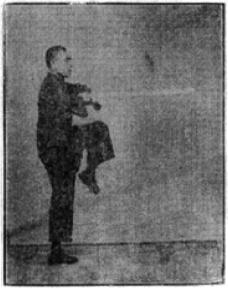
謌曰
Lyrics:
敵人來刺我下盤
黃龍擺尾刁刺還
The opponent attacks with a low stab.
I use YELLOW DRAGON SWINGS ITS TAIL to hook and then return a stab.
此式面向東南。右手將劍托平,劍鋒向前。左手副腕。左足在後直立。右足提起。是為黃龍擺尾。第二動作。此式分上中下三招:上用烏鵲飛空。中用黃龍擺尾。下用葉底藏花。如敵人來刺下盤。則俯身用劍向下刁抹敵腕。右足向前跳弓步,同時發劍刺取敵人之膝。左手劍訣罩於頂前。其姿式如下。
The posture is now facing to the southeast. My right hand is propping with my sword horizontally, the tip pointing forward, my left hand assisting at my right wrist. My left leg is standing straight behind, right leg lifted. This is the second movement of YELLOW DRAGON SWINGS ITS TAIL.
(Techniques that follow from it for each of the three levels could be: high – MAGPIES FLY INTO THE SKY, middle – YELLOW DRAGON SWINGS ITS TAIL, low – FLOWER HIDDEN UNDER THE LEAF.)
If the opponent attacks with a low stab, I lean my torso and send my sword downward with a hooking smearing technique to his wrist. Then my right leg lunges forward into a bow stance while I shoot out my sword with a stab to his knee, my left hand as a swordsman’s hex placed in front of my headtop. This posture is as in the photo below:
第二十九式 黃龍擺尾(三)
POSTURE 29: YELLOW DRAGON SWINGS ITS TAIL – Part 3
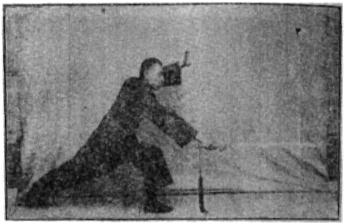
謌曰
Lyrics:
敵人來刺我的面
黃龍擺尾挑底腕
The opponent attacks with a stab to my face.
I use YELLOW DRAGON SWINGS ITS TAIL to lift up under his wrist.
此式面向東南。右手持劍,向前刺下劍,劍刃上下。左手劍訣,罩於頂前。右足在前作弓步。是為黃龍擺尾。第三動作。此式分上中下三招:上用黃龍擺尾。中用走馬回頭。下用倒提金爐。如敵人來刺頭部。則身隨劍向上掛挑敵人之腕。左手劍訣自上而下作圈狀罩於頭前。左足向西作反弓步。其姿式如下。
The posture is now facing to the southeast. My right hand is sending my sword forward and downward with a stab, the edges up and down. My left hand as a swordsman’s hex is placed in front of my headtop. My right leg is forward making a bow stance. This is the third movement of YELLOW DRAGON SWINGS ITS TAIL.
(Techniques that follow from it for each of the three levels could be: high – YELLOW DRAGON SWINGS ITS TAIL, middle – RUNNING HORSE LOOKS BEHIND, low – RETREAT, SPARKING THE GOLDEN FURNACE.)
If the opponent attacks with a stab to my head, my torso goes along with my sword as it goes upward with a hanging technique lifting to his wrist, while my left hand as a swordsman’s hex makes a circle from above to below to again be placed in front of my head, my left leg bending to the west to make a reverse bow stance. This posture is as in the photo below:
第三十式 黃龍擺尾(四)
POSTURE 30: YELLOW DRAGON SWINGS ITS TAIL – Part 4
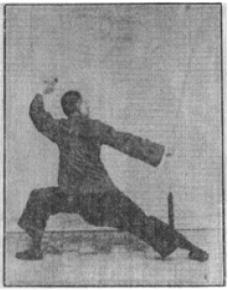
謌曰
Lyrics:
敵人來刺我的腰
黃龍擺尾用托挑
The opponent attacks with a stab to my waist.
I use YELLOW DRAGON SWINGS ITS TAIL to prop and lift.
此式面向東。身向西北傾。右手持劍,劍鋒向上斜立。左手劍訣於頭前。左足在前作反弓步。是為黃龍擺尾第四動作。此式分上中下三招:上用順風領衣。中用黃龍擺尾。下用海底撈月。如敵人來刺腰部。則用劍回掃敵人之腕。右足提起,將劍抱於胸前。其姿式如下。
The posture is now facing to the east, torso inclining to the northwest. My right hand is holding my sword, the tip pointing diagonally upward. My left hand as a swordsman’s hex is in front of my head. My left leg is in front [behind] making a reverse bow stance. This is the fourth movement of YELLOW DRAGON SWINGS ITS TAIL.
(Techniques that follow from it for each of the three levels could be: high – WIND TUGS AT THE ROBE, middle – YELLOW DRAGON SWINGS ITS TAIL, low – TRYING TO SCOOP THE MOON’S REFLECTION FROM THE WATER.)
If the opponent attacks with a stab to my waist, I withdraw my sword with a sweeping action to his wrist, embracing my sword in front of my chest while lifting my right leg. This posture is as in the photo below:
第三十一式 黃龍擺尾(五)
POSTURE 31: YELLOW DRAGON SWINGS ITS TAIL – Part 5

謌曰
Lyrics:
敵人來刺我的肩
淵明折菊上下攔
The opponent attacks with a stab to my shoulder.
I use TAO YUANMING PLUCKS A CHRYSANTHEMUM to block above and below.
此式面向北。右手持劍抱於胸前。劍鋒向前。左手副腕。右足提起。左足直立。是為黃龍擺尾第五動作。如敵人來刺肩部。則左足向西跳步。同時用劍上撩敵腕。敵人還下劍,則左足落步用劍下截敵人之腕,右足在前作點步。其姿式如下。
The posture is now facing to the north [northeast]. My right hand is holding my sword, embracing it in front of my chest, tip pointing forward, my left hand assisting at my right wrist. My right leg is lifted, left leg standing straight. This is the fifth movement of YELLOW DRAGON SWINGS ITS TAIL.
If the opponent attacks with a stab to my shoulder, my left leg jumps to the west while my sword raises up toward his wrist and he tries again with a low stab. When my left leg comes down, I send my sword downward with a checking technique to his wrist, my right leg forward making a pointed stance. This posture is as in the photo below:
第三十二式 淵明折菊
POSTURE 32: TAO YUANMING PLUCKS A CHRYSANTHEMUM

謌曰
Lyrics:
敵人來刺我胸前
黃龍擺尾托帶捲
The opponent attacks with a stab to my chest.
I use YELLOW DRAGON SWINGS ITS TAIL to prop leading into rolling.
此式面向東北。右手持劍,劍鋒向右方下垂,右足在前作點步。左手劍訣罩於頭前。是為淵明折菊。此式分上中下三招:上用連環劍。中用白馬分鬃。下用黃龍擺尾。如敵人來刺胸前。則身隨劍向前橫捲敵人之腕。右足上弓步,用劍托捲隨式提起。左手副腕。其姿式與第二十七式同。
The posture is now facing to the northeast. My right hand is holding my sword, the tip hanging down toward the right. My right leg is forward making a pointed stance. My left hand as a swordsman’s hex is placed in front of my head. This is TAO YUANMING PLUCKS A CHRYSANTHEMUM.
(Techniques that follow from it for each of the three levels could be: high – CONTINUOUS SWORD, middle – WHITE HORSE PARTS ITS MANE, low – YELLOW DRAGON SWINGS ITS TAIL.)
If the opponent attacks with a stab to my chest, my torso goes along with my sword as it goes forward and across with a rolling technique to his wrist. My right leg steps forward into a bow stance and I use my sword to prop and roll as the posture lifts into place, my left hand assisting at my right wrist. This posture is the same as in Posture 27.
第三十三式 黃龍擺尾(一)
POSTURE 33: YELLOW DRAGON SWINGS ITS TAIL – Part 1
第三十四式 黃龍擺尾(二)
POSTURE 34: YELLOW DRAGON SWINGS ITS TAIL – Part 2
第三十五式 黃龍擺尾(三)
POSTURE 35: YELLOW DRAGON SWINGS ITS TAIL – Part 3
第三十六式 黃龍擺尾(四)
POSTURE 36: YELLOW DRAGON SWINGS ITS TAIL – Part 4
第三十七式 黃龍擺尾(五)
POSTURE 37: YELLOW DRAGON SWINGS ITS TAIL – Part 5
以上五式與前同。故挿圖從略。惟前五式向東南走。此五式向東北走。方向不同而動作相同。因本劍法原來之結構如此,未便割棄。
The above five postures are the same as before, therefore there are no photos for them here. Previously they moved to the southeast and now they are moving to the northeast. The orientation is different but the movement is the same. Because this is the original structure of this sword set, it would not be appropriate to trim away these repeated postures.
第三十八式 淵明折菊
POSTURE 38: TAO YUANMING PLUCKS A CHRYSANTHEMUM
謌曰
Lyrics:
敵人來刺我的面
海底撈月妙無邊
The opponent attacks with a stab to my face.
I use TRYING TO SCOOP THE MOON’S REFLECTION FROM THE WATER, which is wondrous without compare.
此式面向東北。式見前。茲從略。此式亦可用以下三招:上用望巧雲。中用白馬分鬃。下用海底撈月。如敵來刺面部。則用劍上托敵腕。其姿式如下。
The posture is now facing to the northeast. The posture is as described before and so the description is not repeated here.
(Techniques that follow from it for each of the three levels could be: high – GAZING UPON BEAUTIFUL CLOUDS, middle – WHITE HORSE PARTS ITS MANE, low – TRYING TO SCOOP THE MOON’S REFLECTION FROM THE WATER.)
If the opponent attacks with a stab to my face, I send my sword upward with a propping technique to his wrist. This posture is as in the photo below:
第三十九式 海底撈月(一)
POSTURE 39: TRYING TO SCOOP THE MOON’S REFLECTION FROM THE WATER – Part 1
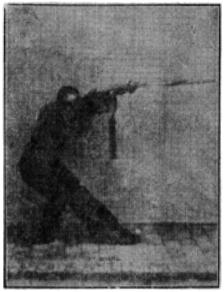
謌曰
Lyrics:
敵人如若向後退
海底撈月托掃追
If the opponent retreats away,
I use TRYING TO SCOOP THE MOON’S REFLECTION FROM THE WATER to chase him with propping and sweeping.
此式面向東。右手持劍,向上托敵人之腕,手心向外。左手劍訣罩於面前。右足在前,仍作點步。是為海底撈月第一動作。此勢練習時。可畧停。用着時。則身隨劍式向前上托。同時進左足。跳步掃取敵人之下部,其姿式如下。
The posture is now facing to the east. My right hand, palm outward, is sending my sword upward with a propping technique to the opponent’s wrist, My left hand as a swordsman’s hex is placed in front of my face. My right leg is forward, again making a pointed stance. This is the first movement of TRYING TO SCOOP THE MOON’S REFLECTION FROM THE WATER.
When practicing the posture, there can be a slight pause, but when applying it, [it continues right into the next:]
My torso goes along with my sword as it goes forward and upward to prop. At the same time, my left leg advances with a jumping step [coming down with my right leg advancing beyond it into a low stance] so I can sweep with my sword to catch his lower body. This posture is as in the photo below:
第四十式 海底撈月(二)
POSTURE 40: TRYING TO SCOOP THE MOON’S REFLECTION FROM THE WATER – Part 2
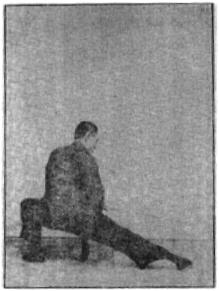
謌曰
Lyrics:
敵人來刺我下盤
夜叉探海向下攔
The opponent attacks with a low stab.
I use NIGHT DEMON SEARCHES THE SEA to block downward.
此式面向東,身向北。右手持劍,抱於胯前。劍鋒向北。左手副腕。右足在前作鋪腿式。是為海底撈月第二動作。此式分上中下三招:上用橫劍截腕。中用連環劍。下用夜叉探海。如敵人來刺足部。則身隨劍起,向下探截敵人之腕。其姿式如下。
The posture is now facing to the east, torso squared to the north. My right hand is holding my sword, embraced in front of my hips, the tip pointing to the north [east], my left hand assisting at my right wrist. My right leg is forward making a spreading stance. This is the second movement of TRYING TO SCOOP THE MOON’S REFLECTION FROM THE WATER.
(Techniques that follow from it for each of the three levels could be: high – TAKING THE SWORD ACROSS TO CHECK HIS WRIST, middle – CONTINUOUS SWORD, low – NIGHT DEMON SEARCHES THE SEA.)
If the opponent attacks with a stab to my leg, my body goes along with my sword as it rises and reaches downward with a checking technique to his wrist. This posture is as in the photo below:
第四十一式 夜叉探海
POSTURE 41: NIGHT DEMON SEARCHES THE SEA
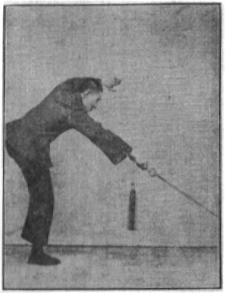
謌曰
Lyrics:
敵人來刺我的面
望巧雲上截外腕
The opponent attacks with a stab to my face.
I use GAZING UPON BEAUTIFUL CLOUDS to check to the outside of his wrist.
此式面向正東。右手持劍向下截敵人之腕。左手劍訣罩於頂前。右足在前直立。左足提起。是為夜叉探海。此式分上中下三招:上用望巧雲。中用摘星換月。下用淵明折菊。如敵人來刺面部。則身向後,用坐步。同時劍向前上方截取敵人之外腕。其姿式如下。
The posture is now facing to the east. My right hand is holding my sword, performing a downward checking technique to the opponent’s wrist. My left hand as a swordsman’s hex is placed in front of my headtop. My right leg is standing in front, left leg lifted behind. This is NIGHT DEMON SEARCHES THE SEA.
(Techniques that follow from it for each of the three levels could be: high – GAZING UPON BEAUTIFUL CLOUDS, middle – PLUCK AWAY THE STARS & REPLACE THEM WITH THE MOON, low – TAO YUANMING PLUCKS A CHRYSANTHEMUM.)
If the opponent attacks with a stab to my face, my body goes to the rear into a sitting stance, my sword at the same time going forward and upward with a checking technique to the outside of his wrist. This posture is as in the photo below:
第四十二式 望巧雲
POSTURE 42: GAZING UPON BEAUTIFUL CLOUDS

謌曰
Lyrics:
敵人來刺我的胸
靈貓捕鼠點頭工
The opponent attacks with a stab to my chest.
I use QUICK CAT CATCHES THE MOUSE to skillfully tap to his head.
此式面向正東,右手持劍向上截敵人之腕,左手副腕。右足在前作點步,是為望巧雲。此式與橫劍截腕。名異而實同。此式分上中下三招:上用白鶴亮翅。中用摘星換月。下用靈貓捕鼠。如敵來刺前胸。則用劍向下外掛敵腕。同時右足向後撤跳步,劍由下作圓圈。翻上以上點敵頭或腕。左足向東作點步。其姿式如下。
The posture is now facing to the east. My right hand is sending my sword upward with a checking technique to the opponent’s wrist, my left hand assisting at my right wrist. My right leg is forward making a pointed stance. This is GAZING UPON BEAUTIFUL CLOUDS. Although the names are different, it is actually the same thing as TAKING THE SWORD ACROSS TO CHECK HIS WRIST.
(Techniques that follow from it for each of the three levels could be: high – WHITE CRANE SHOWS ITS WINGS, middle – PLUCK AWAY THE STARS & REPLACE THEM WITH THE MOON, low – QUICK CAT CATCHES THE MOUSE.)
If the opponent attacks with a stab to my chest, I send my sword downward with an outward hanging technique to his wrist while my right leg withdraws with a jumping step, my sword circling from below and turning over upward to tap on top of his head or wrist. My left leg is pointing to the east making a pointed stance. This posture is as in the photo below:
第四十三式 靈貓捕鼠
POSTURE 43: QUICK CAT CATCHES THE MOUSE

謌曰
Lyrics:
敵人來刺我的面
烏鵲飛空托底腕
The opponent attacks with a stab to my face.
I use MAGPIES FLY INTO THE SKY to prop under his wrist.
此式面向正東。右手持劍,劍鋒向下平點。左手劍訣,罩於頂前。左足在前作點步。是為靈貓捕鼠。此式分上中下三招:上用烏鵲飛空。中用藤蘿掛壁。下用連環劍。如敵人來刺我面。則左足向後退弓步。同時用劍上托敵人之腕。其姿式如下。
The posture is now facing to the east. My right hand is holding my sword, the tip pointing downward with a level tapping technique. My left hand as a swordsman’s hex is placed in front of my headtop. My left leg is forward making a pointed stance. This is QUICK CAT CATCHES THE MOUSE.
(Techniques that follow from it for each of the three levels could be: high – MAGPIES FLY INTO THE SKY, middle – VINES CLIMBING THE WALL, low – CONTINUOUS SWORD.)
If the opponent attacks with a stab to my face, I retreat my left leg into a bow stance while using my sword to do a propping technique to his wrist. This posture is as in the photo below:
第四十四式 烏鵲飛空
POSTURE 44: MAGPIES FLY INTO THE SKY
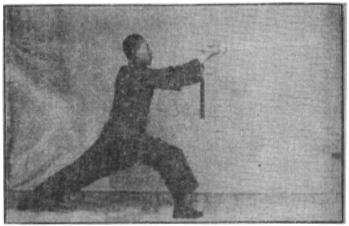
謌曰
Lyrics:
敵人來刺我胸前
浩然折梅刁外腕
The opponent attacks with a stab to my chest.
I use MENG HAORAN PLUCKS A PLUM to do a hooking technique to the outside of his wrist.
此式面向正東。右手持劍,劍鋒向前。左手副腕。右足在前作弓步。是為烏鵲飛空。此式分上中下三招:上用連環劍。中用浩然折梅,下用走馬回頭。如敵人來刺胸前。則右足後撤,左足在前作點步。同時翻腕。刁取敵人外腕。其姿式如下。
The posture is now facing to the east. My right hand is holding my sword, the tip pointing forward, my left hand assisting at my right wrist. My right leg is forward making a bow stance. This is MAGPIES FLY INTO THE SKY.
(Techniques that follow from it for each of the three levels could be: high – CONTINUOUS SWORD, middle – MENG HAORAN PLUCKS A PLUM, low – RUNNING HORSE LOOKS BEHIND.)
If the opponent attacks with a stab to my chest, my right leg withdraws so my left leg is forward making a pointed stance while I turn over my wrist to do a hooking technique to the outside of his wrist. This posture is as in the photo below:
第四十五式 浩然折梅
POSTURE 45: MENG HAORAN PLUCKS A PLUM
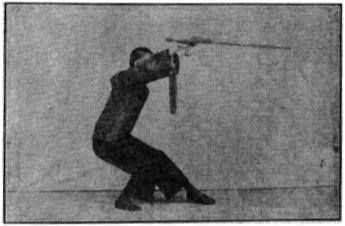
謌曰
Lyrics:
敵人來刺我的胸
劍刺三里先用捧
The opponent attacks with a stab to my chest.
I use SWORD STABS THE LENGTH OF A MILE, which begins with carrying.
此式面向正東。右手持劍,作刁式,劍鋒向前。左手劍訣罩於頭前。左足在前作點步。是為浩然折梅。此式分上中下三招:上用打落金錢。中用劍刺三里。下用淵明折菊。如敵人來刺胸部,則用劍捧敵人之底腕。左足向後退步。右足提起。其姿式如下。
The posture is now facing to the east. My right hand is performing a hooking technique with my sword, the tip pointing forward. My left hand as a swordsman’s hex is placed in front of my head. My left leg is forward making a pointed stance. This is MENG HAORAN PLUCKS A PLUM.
(Techniques that follow from it for each of the three levels could be: high – SLAMMING DOWN MONEY, middle – SWORD STABS THE LENGTH OF A MILE, low – TAO YUANMING PLUCKS A CHRYSANTHEMUM.)
If the opponent attacks with a stab to my chest, I use my sword to do a carrying technique to his wrist, my left leg retreating, right leg lifting. This posture is as in the photo below:
第四十六式 劍刺三里(一)
POSTURE 46: SWORD STABS THE LENGTH OF A MILE – Part 1
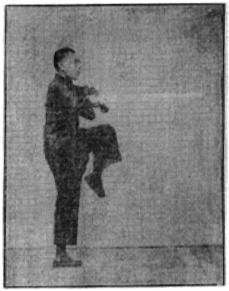
謌曰
Lyrics:
敵人來刺我的膝
劍刺三里追抹擠
The opponent attacks with a stab to my knee.
I use SWORD STABS THE LENGTH OF A MILE to chase with a smear and a stab.
此式面向正東。右手持劍,在胸前作捧式。劍鋒向前。左手副腕。左足直立。右足提起。是為劍刺三里第一動作。如敵人來刺膝部。則身隨劍向前。下摸敵腕。同時落右足,而後進。左足跳步作騎馬式,擠刺敵人之腰部。其姿式如下。
The posture is now facing to the east. My right hand is holding my sword, performing a carrying technique in front of my chest, the tip pointing forward, my left hand assisting at my right wrist. My left leg is standing straight, right leg lifted. This is the first movement of SWORD STABS THE LENGTH OF A MILE.
If the opponent attacks with a stab to my knee, my body goes along with my sword as it goes forward and downward with a smearing technique to his wrist. At the same time, my right leg comes down then advances as my left leg does a jumping step to make a horse-riding posture, and I squeeze forth a stab to his waist. This posture is as in the photo below:
第四十七式 劍刺三里(二)
POSTURE 47: SWORD STABS THE LENGTH OF A MILE – Part 2

謌曰
Lyrics:
敵人來取我右肩
平地挿香挑底腕
The opponent attacks with a stab to my right shoulder.
I use INSERTING A STICK OF INCENSE INTO LEVEL GROUND to lift under his wrist.
此式面向東,身向北。右手持劍刺平。左手劍訣罩於頂前。二足作騎馬式。是為劍刺三里第二動作。此式分上中下三招:上用平地挿香。中用藤蘿掛壁。下用靈貓捕鼠。如敵人來刺肩部。則左足向右足並立。劍向上挑。其姿式如下。
The posture is now facing to the east, torso squared to the north. My right hand is holding my sword, stabbing level. My left hand as a swordsman’s hex is placed in front of my headtop. My legs are making a horse-riding stance. This is the second movement of SWORD STABS THE LENGTH OF A MILE.
(Techniques that follow from it for each of the three levels could be: high – INSERTING A STICK OF INCENSE INTO LEVEL GROUND, middle – VINES CLIMBING THE WALL, low – QUICK CAT CATCHES THE MOUSE.)
If the opponent attacks with a stab to my shoulder, my left foot moves to stand next to my right foot, my sword going upward with a lifting technique. This posture is as in the photo below:
第四十八式 平地挿香
POSTURE 48: INSERTING A STICK OF INCENSE INTO LEVEL GROUND

謌曰
Lyrics:
敵人來刺我的肋
藤蘿掛壁向下揮
The opponent attacks with a stab to my ribs.
I use VINES CLIMBING THE WALL to wipe away downward.
此式面向東北。右手持劍,劍鋒向上直立,位於身之右側。左手副腕。二足並立。是為平地挿香。此式分上中下三招:上用白鶴亮翅。中用藤蘿掛壁。下用海底撈月。如敵人來刺脇部。則用劍向下掛敵人之腕,右足提起。同時劍由下翻上。扣點敵腕。其姿式如下。
The posture is now facing to the northeast. My right hand is holding my sword, the tip pointing straight up, positioned to the right side of my body, my left hand assisting at my right wrist. My feet are together. This is INSERTING A STICK OF INCENSE INTO LEVEL GROUND.
(Techniques that follow from it for each of the three levels could be: high – WHITE CRANE SHOWS ITS WINGS, middle – VINES CLIMBING THE WALL, low – TRYING TO SCOOP THE MOON’S REFLECTION FROM THE WATER.)
If the opponent attacks with a stab to my ribs, I send my sword downward with a hanging technique to his wrist, then lift my right leg while turning my sword over upward to do a covering tap to his wrist. This posture is as in the photo below:
第四十九式 藤蘿掛壁
POSTURE 49: VINES CLIMBING THE WALL

謌曰
Lyrics:
敵人如若往後退
遮前擋後向前追
If the opponent retreats away,
I use COVER IN FRONT & BLOCK BEHIND to chase him.
此式面向東北。右手持劍在脇下提平,劍鋒向前,左手劍訣罩於頂前。右足在前提起,左足直立。是為藤蘿掛壁。此式分上中下三招:上用平地挿香。中用遮前擋後。下用進步連環。如敵人往後退。則身隨劍向前刺平,右足上弓步,左手副腕。其姿式如下。
The posture is now facing to the northeast. My right hand is holding my sword, lifted level below my ribs, the tip pointing forward. My left hand as a swordsman’s hex is placed in front of my headtop. My right leg is lifted in front, left leg standing straight. This is VINES CLIMBING THE WALL.
(Techniques that follow from it for each of the three levels could be: high – INSERTING A STICK OF INCENSE INTO LEVEL GROUND, middle – COVER IN FRONT & BLOCK BEHIND, low – ADVANCE, CONTINUOUS SWORD.)
If the opponent retreats, my torso goes along with my sword as it does a level stab forward, my left hand assisting at my right wrist, my right leg advancing into a bow stance. This posture is as in the photo below:
第五十式 遮前擋後(一)
POSTURE 50: COVER IN FRONT & BLOCK BEHIND – Part 1
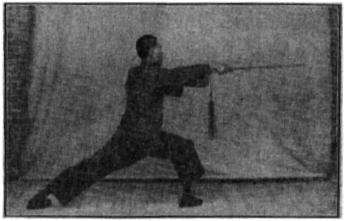
謌曰
Lyrics:
敵人來刺我右臂
遮前擋後往後退
The opponent attacks with a stab to my right shoulder.
I use COVER IN FRONT & BLOCK BEHIND to retreat.
此式面向東北。右手持劍刺平。左手副腕。右足在前作弓步。是為遮前擋後第一動作。此式分上中下三招:上用順風領衣。中用遮前擋後。下用黃龍擺尾。如敵人由後來刺左足。則左足撤向左後方,同時轉身向東南刺取敵人之腕。左手副腕。左足在前作弓步。其姿式如下。
The posture is now facing to the northeast. My right hand is holding my sword, stabbing level, my left hand assisting at my right wrist. My right leg is forward making a bow stance. This is the first movement of COVER IN FRONT & BLOCK BEHIND.
(Techniques that follow from it for each of the three levels could be: high – WIND TUGS AT THE ROBE, middle – COVER IN FRONT & BLOCK BEHIND, low – YELLOW DRAGON SWINGS ITS TAIL.)
If an opponent attacks from behind with a stab to my left leg, my left leg withdraws to the left rear [right rear] while my body turns around [to the left] and I go to the southeast with a stab to his wrist, my left hand assisting at my right wrist, my left leg forward making a bow stance. This posture is as in the photo below:
第五十一式 遮前擋後(二)
POSTURE 51: COVER IN FRONT & BLOCK BEHIND – Part 2
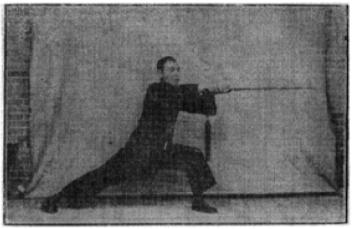
謌曰
Lyrics:
敵人來刺我左肩
順風領衣托底腕
The opponent attacks with a stab to my left shoulder.
I use WIND TUGS AT THE ROBE to prop under his wrist.
此式面向東南。右手持劍向前刺平。左手副腕。左足在前作弓步。是為遮前擋後第二動作。此式分上中下三招:上用順風領衣。中用封侯掛印。下用夜叉探海。如敵人來刺左肩,則左足向後退弓步,用劍向上托敵人之底腕。左手副腕。其姿式如下。
The posture is now facing to the southeast. My right hand is sending my sword forward with a level stab, my left hand assisting at my right wrist. My left leg is forward making a bow stance. This is the second movement of COVER IN FRONT & BLOCK BEHIND.
(Techniques that follow from it for each of the three levels could be: high – WIND TUGS AT THE ROBE, middle – NOBLEMAN HANGS UP HIS SEAL, low – NIGHT DEMON SEARCHES THE SEA.)
If an opponent attacks with a stab to my right shoulder, my left leg retreats into a bow stance while I send my sword upward with a propping technique under his wrist, my left hand assisting at my right wrist. This posture is as in the photo below:
第五十二式 順風領衣(一)
POSTURE 52: WIND TUGS AT THE ROBE – Part 1
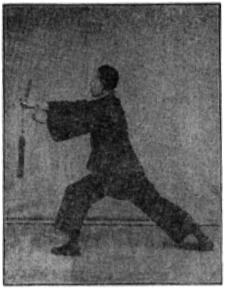
謌曰
Lyrics:
敵人來刺我右肩
順風領衣向右翻
The opponent attacks with a stab to my right shoulder.
I use WIND TUGS AT THE ROBE to turn over to the right.
此式面向西北。右手持劍向上托平。左手副腕。左足在前作弓步。是為順風領衣第一動作。此式分上中下三招:上用順風領衣。中用黃龍擺尾。下用快馬加鞭。如敵來刺右肩。則身隨劍向右托敵人之底腕。左手副腕。二足不動轉向東作弓步。其姿式如下。
The posture is now facing to the northwest. My right hand is sending my sword upward with a level propping technique, my left hand assisting at my right wrist. My left leg is forward making a bow stance. This is the first movement of WIND TUGS AT THE ROBE.
(Techniques that follow from it for each of the three levels could be: high – WIND TUGS AT THE ROBE, middle – YELLOW DRAGON SWINGS ITS TAIL, low – QUICKEN THE HORSE WITH MORE WHIPPING.)
If the opponent attacks with a stab to my right shoulder, my torso goes along with my sword as it goes to the right with a propping technique under his wrist, my left hand assisting at my right wrist. My feet stay where they are as I rotate to make an eastward bow stance. This posture is as in the photo below:
第五十三式 順風領衣(二)
POSTURE 53: WIND TUGS AT THE ROBE – Part 2

謌曰
Lyrics:
敵人來刺我外腕
打落金錢向下點
The opponent attacks with a stab to the outside of my wrist.
I use SLAMMING DOWN MONEY to tap downward.
此式面向正東。右手持劍向上橫平。左手副腕。右足在前作弓步。是為順風領衣第二動作。此式分上中下三招:上用打落金錢。中用仙人入洞。下用葉底藏花。如敵人來刺外腕。則身隨劍向前下劈點敵人之腕。同時左足向右足跟並立。其姿式如下。
The posture is now facing to the east. My right hand is holding my sword up and horizontal, my left hand assisting at my right wrist. My right leg is forward making a bow stance. This is the second movement of WIND TUGS AT THE ROBE.
(Techniques that follow from it for each of the three levels could be: high – SLAMMING DOWN MONEY, middle – IMMORTAL GOES INTO HIS CAVE, low – FLOWER HIDDEN UNDER THE LEAF.)
If the opponent attacks with a stab to the outside of my wrist, my torso goes along with my sword as it chops down with a tap to his wrist, my left foot at the same time following to stand next to my right foot. This posture is as in the photo below:
第五十四式 打落金錢
POSTURE 54: SLAMMING DOWN MONEY
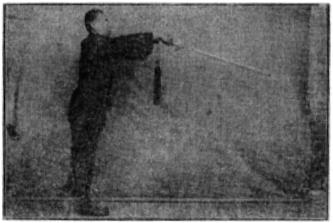
謌曰
Lyrics:
敵人來刺我左肩
連環劍式托底腕
The opponent attacks with a stab to my left shoulder.
I use CONTINUOUS SWORD to prop under his wrist.
此式面向東北。右手持劍下點。左手副腕。兩足並立。是為打落金錢。姿式與蜻蜓點水略同。此式分上中下三招:上用封侯掛印。中用連環劍。下用連環劍。如敵人來刺左肩。則轉身向左,用劍托敵人之底腕。同時右足向西上步,左足在後上偸步。其姿式如下。
The posture is now facing to the northeast. My right hand is sending my sword downward with a tapping technique, my left hand assisting at my right wrist. My feet are together. This is SLAMMING DOWN MONEY, which is almost the same as DRAGONFLY SKIMS THE WATER.
(Techniques that follow from it for each of the three levels could be: high – NOBLEMAN HANGS UP HIS SEAL, middle – CONTINUOUS SWORD, low – CONTINUOUS SWORD.)
If the opponent attacks with a stab to my left shoulder, I turn my body around to the left while sending my sword in a propping technique under his wrist. At the same time, my right leg steps forward to the west, my left leg stepping past it into a stealth stance. This posture is as in the photo below:
第五十五式 連環劍(一)
POSTURE 55: CONTINUOUS SWORD – Part 1
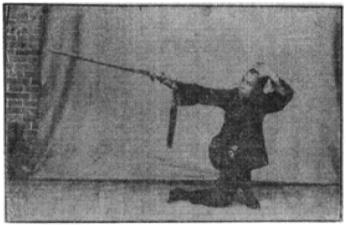
謌曰
Lyrics:
敵人來刺我右肩
連環劍式跟上前
The opponent attacks with a stab to my right shoulder.
I use CONTINUOUS SWORD to follow through upward and forward.
此式面向西南。右手持劍上托,微斜。左手劍訣罩於頂前。右足在前,左足在後,作偸步。是為連環劍第一動作。此式分上中下三招:上用進步連環。中用浩然折梅。下用倒步連環。如敵人來刺右肩。則右足向西平進。左足在後仍上偸步。同時用劍自下而上作圓圈,反把以托敵腕。其姿式如下。
The posture is now facing to the southwest. My right hand is sending my sword upward and slightly diagonally with a propping technique. My left hand as a swordsman’s hex is placed in front of my headtop. My right leg is in front, left leg behind it, making a stealth stance. This is the first movement of CONTINUOUS SWORD.
(Techniques that follow from it for each of the three levels could be: high – ADVANCE, CONTINUOUS SWORD, middle – MENG HAORAN PLUCKS A PLUM, low – RETREAT, CONTINUOUS SWORD.)
If the opponent attacks with a stab to my right shoulder, my right leg advances across to the west, my left leg again stepping past it into a stealth stance. At the same time, I send my sword in a circle so it goes up from below in a reverse-grip propping technique to his wrist. This posture is as in the photo below:
第五十六式 連環劍(二)
POSTURE 56: CONTINUOUS SWORD – Part 2
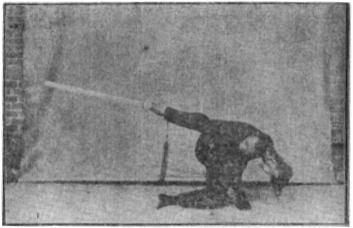
謌曰
Lyrics:
敵人來刺我下盤
連環劍式截外腕
The opponent attacks with a low stab.
I use CONTINUOUS SWORD to check to the outside of his wrist.
此式面向西南。右手持劍上托用反把。左手劍訣罩於頂前。右足在前,左足在後作偸步。是為連環劍第二動作。如敵人來刺腿部。則左足撤回,右足提起。同時將劍撤回,用劍鋒自上而下點敵腕。其姿式如下。
The posture is now facing to the southwest. My right hand is sending my sword upward with a reverse-grip propping technique. My left hand as a swordsman’s hex is placed in front of my headtop. My right leg is in front, left leg behind it, making a stealth stance. This is the second movement of CONTINUOUS SWORD.
If the opponent attacks with a stab to my leg, my left leg withdraws and my right leg lifts. At the same time, I withdraw my sword and send it down from above with a tapping technique to his wrist. This posture is as in the photo below:
第五十七式 連環劍(三)
POSTURE 57: CONTINUOUS SWORD – Part 3
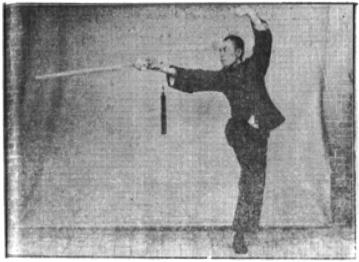
謌曰
Lyrics:
敵人來刺我的面
連環劍式截外腕
The opponent attacks with a stab to my face.
I use CONTINUOUS SWORD to again check to the outside of his wrist.
此式面向西北。右手持劍向下反點。左足直立。右足提起,擰身作獨立步。左手劍訣斜罩頂上。是為連環劍第三動作。此式分上中下三招:上用望巧雲。中用倒坐連環。下用白馬分鬃。如敵人來刺面部。則身隨劍向右轉。落右足上左足,用劍自上而下截取敵人之外腕。再翻身作騎馬式。其姿式如下。
The posture is now facing to the northwest. My right hand is sending my sword downward with a reverse tapping technique [i.e. using the upper edge]. My left leg is standing, right leg lifted, torso twisted, making a one-legged stance. My left hand as a swordsman’s hex is placed at an angle above my headtop. This is the third movement of CONTINUOUS SWORD.
(Techniques that follow from it for each of the three levels could be: high – GAZING UPON BEAUTIFUL CLOUDS, middle – RETREAT, CONTINUOUS SWORD, low – WHITE HORSE PARTS ITS MANE.)
If the opponent attacks with a stab to my face, my torso goes along with my sword, turning around to the right while I lower my right leg and step forward with my left leg [then step behind it with my right leg in a brief twisted stance], sending my sword down from above with a checking technique to the outside of his wrist as I turn the rest of the way around and make a horse-riding stance. This posture is as in the photo below:
第五十八式 連環劍(四)
POSTURE 58: CONTINUOUS SWORD – Part 4
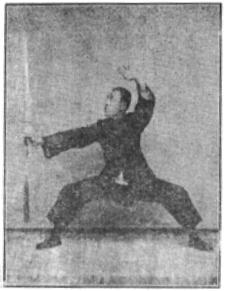
謌曰
Lyrics:
敵人來刺我前胸
摘星換月托腕工
The opponent attacks with a stab to my chest.
I use PLUCK AWAY THE STARS & REPLACE THEM WITH THE MOON to skillfully prop to his wrist.
此式面向正南。右手持劍,劍鋒向上。左手劍訣罩於頂前。兩足作騎馬式。是為連環劍第四動作。此式分上中下三招:上用順風領衣。中用摘星換月。下用黃龍翻身。如敵人來刺前胸。則身隨劍向前托敵人之底腕。同時左足提起以便探身。其姿式如下。
The posture is now facing to the south. My right hand is holding my sword, the tip pointing upward. My left hand as a swordsman’s hex is placed in front of my headtop. My legs are making a horse-riding stance. This is the fourth movement of CONTINUOUS SWORD.
(Techniques that follow from it for each of the three levels could be: high – WIND TUGS AT THE ROBE, middle – PLUCK AWAY THE STARS & REPLACE THEM WITH THE MOON, low – YELLOW DRAGON TURNS AROUND.)
If the opponent attacks with a stab to my chest, my torso goes along with my sword as it goes forward with a propping technique to his wrist. At the same time, my left leg lifts to make it easier to reach out with my torso. This posture is as in the photo below:
第五十九式 摘星換月(一)
POSTURE 59: PLUCK AWAY THE STARS & REPLACE THEM WITH THE MOON – Part 1
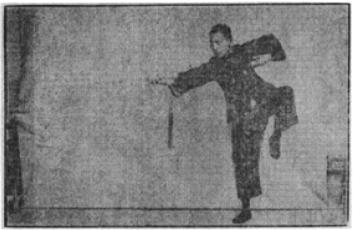
謌曰
Lyrics:
敵人來刺我右脇
摘星換月用刁隨
The opponent attacks with a stab to my right ribs.
I use PLUCK AWAY THE STARS & REPLACE THEM WITH THE MOON to follow with a hooking technique.
此式面向西南。右手持劍向前作托式。左手劍訣抵於左胸。左足提起。右足直立。是為摘星換月第一動作。如敵人還刺右脇。則翻腕用劍向下刁取敵人之腕。同時左足落平,右足提起。其姿式如下。
The posture is now facing to the southwest. My right hand is sending my sword forward with a propping technique. My left hand as a swordsman’s hex supports to the left side of my chest. My left leg is lifted, right leg standing straight. This is the first movement of PLUCK AWAY THE STARS & REPLACE THEM WITH THE MOON.
If the opponent counters with a stab to my right ribs, I turn over my wrist, sending my sword downward with a hooking technique to his wrist while my left leg comes down and my right leg lifts. This posture is as in the photo below:
第六十式 摘星換月(二)
POSTURE 60: PLUCK AWAY THE STARS & REPLACE THEM WITH THE MOON – Part 2
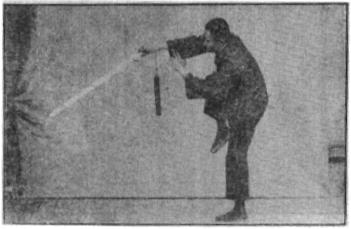
謌曰
Lyrics:
敵人來刺我左脇
摘星換月刁刺追
The opponent attacks with a stab to my left ribs.
I use PLUCK AWAY THE STARS & REPLACE THEM WITH THE MOON to chase with hooking and stabbing.
此式面向西南。右手持劍向前作刁式。左手副腕。左足直立。右足提起。是為摘星換月第二動作。如敵人復來刺前胸。則右足向前落弓步,隨劍向前刺敵人之左脇。其姿式如下。
The posture is now facing to the southwest. My right hand is sending my sword forward with a hooking technique, my left hand assisting at my right wrist. My left leg is standing straight, right leg lifted. This is the second movement of PLUCK AWAY THE STARS & REPLACE THEM WITH THE MOON.
If the opponent counters with a stab to my chest, my right leg comes down forward into a bow stance as my sword stabs forward to his left ribs. This posture is as in the photo below:
第六十一式 摘星換月(三)
POSTURE 61: PLUCK AWAY THE STARS & REPLACE THEM WITH THE MOON – Part 3
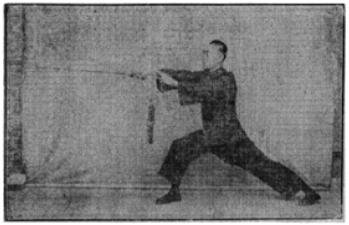
謌曰
Lyrics:
敵人來刺我的腿
走馬回頭掃腕退
The opponent attacks with a stab to my leg.
I use RUNNING HORSE LOOKS BEHIND to sweep to his wrist while retreating.
此式面向西南。右手持劍向前刺平。左手副腕。右足在前作弓步。是為摘星換月第三動作。此式與漁郎問津第二式名異實同。此式分上中下三招:上用白鶴亮翅。中用走馬回頭。下用海底撈月。如敵人來刺右脇。則腰身向左旋,隨手用劍鋒向下掃取敵人之腕。同時右足向左前方作拗步以避敵鋒。其姿式如下。
The posture is now facing to the southwest. My right hand is sending my sword forward with a level stab, my left hand assisting at my right wrist. My right leg is forward making a bow stance. This is the third movement of PLUCK AWAY THE STARS & REPLACE THEM WITH THE MOON. Although the name is different, this posture is actually the same as FISHERMAN EXAMINES FOR WHERE TO CROSS THE RIVER – Part 2.
(Techniques that follow from it for each of the three levels could be: high – WHITE CRANE SHOWS ITS WINGS, middle – RUNNING HORSE LOOKS BEHIND, low – TRYING TO SCOOP THE MOON’S REFLECTION FROM THE WATER.)
If the opponent attacks with a stab to my right ribs, I twist my waist to the left, sweeping the tip of my sword downward to catch his wrist, while my right leg goes to the forward left to make a twisted stance, thereby evading his sword tip. This posture is as in the photo below:
第六十二式 走馬回頭(一)
POSTURE 62: RUNNING HORSE LOOKS BEHIND – Part 1
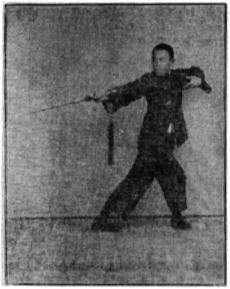
謌曰
Lyrics:
敵人來刺我的腰
走馬回頭刺取刁
The opponent attacks with a stab to my waist.
I use RUNNING HORSE LOOKS BEHIND to stab and hook.
此式面向東南。右手持劍,下捲敵腕。左手劍訣抵於胸前。右足在前作拗步。是為走馬回頭第一動作。此式分上中下三招:上用望巧雲。中用進步連環。下用走馬回頭。如敵人來刺腰部。則左足提起,斜向右前方作拗步式,即用劍刁取敵人之腕。敵人再刺,則落步斜取敵人之脇。其姿式與摘星換月第三式同。
The posture is now facing to the southeast. My right hand is sending my sword downward with a rolling technique to the opponent’s wrist. My left hand as a swordsman’s hex supports in front of my chest. My right leg is forward making a twisted stance. This is the first movement of RUNNING HORSE LOOKS BEHIND.
(Techniques that follow from it for each of the three levels could be: high – GAZING UPON BEAUTIFUL CLOUDS, middle – ADVANCE, CONTINUOUS SWORD, low – RUNNING HORSE LOOKS BEHIND.)
If the opponent attacks with a stab to my waist, I lift my left leg and step [around my right leg] to the forward right to make a twisted stance, using my sword to do a hooking technique to his wrist. He stabs again, so I step down diagonally [forward with my right leg into a bow stance], stabbing to his ribs. This posture is the same as PLUCK AWAY THE STARS & REPLACE THEM WITH THE MOON – Part 3.
第六十三式 走馬回頭(二)
POSTURE 63: RUNNING HORSE LOOKS BEHIND – Part 2
謌曰
Lyrics:
敵人來刺我的面
三斷劍式挑底腕
The opponent attacks with a stab to my face.
I use THREE STOPPINGS POSTURE to lift under his wrist.
此式與摘星換月第三式同,從畧。此式亦可用以下三招:上用封侯掛印。中用三斷式。下用白馬分鬃。如敵人來刺面部。則身向左轉,隨用劍上挑敵人之底腕。同時左足撤點步。其姿式如下。
The posture is the same as in PLUCK AWAY THE STARS & REPLACE THEM WITH THE MOON – Part 3, and so the description is not repeated.
(Techniques that follow from it for each of the three levels could be: high – NOBLEMAN HANGS UP HIS SEAL, middle – THREE STOPPINGS POSTURE, low – WHITE HORSE PARTS ITS MANE.)
If the opponent attacks with a stab to my face, I turn my body to the left, sending my sword upward with a lifting technique under his wrist, while my left leg withdraws to make a pointed stance [foot slightly lifted]. This posture is as in the photo below:
第六十四式 三斷式(一)
POSTURE 64: THREE STOPPINGS POSTURE – Part 1
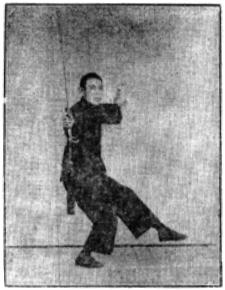
謌曰
Lyrics:
敵人如要托底腕
三斷劍式向下點
If the opponent wants to attack with a propping technique under my wrist.
I use THREE STOPPINGS POSTURE to tap downward.
此式面向正東。右手持劍,劍鋒向上直立。左手劍訣舒出與肩平。左足在前作點步。是為三斷式第一動作。此式分上中下三招:上用力劈華山。中用三斷式。下用金花落地。如敵人來托敵腕。則左足上步,同時隨勢下點敵腕。其姿式如下。
The posture is now facing to the [south, torso squared to the] east. My right hand is holding my sword, the tip pointing straight up. My left hand as a swordsman’s hex is extended at shoulder level. My left leg is forward making a pointed stance. This is the third movement of THREE STOPPINGS POSTURE.
(Techniques that follow from it for each of the three levels could be: high – POWERFUL CHOP THROUGH MT. HUA, middle – THREE STOPPINGS POSTURE, low – GOLDEN PETALS FALL TO THE GROUND.)
If the opponent attacks with a propping technique to my wrist, I step forward with my left leg while following the momentum downward with a tapping technique to his wrist. This posture is as in the photo below:
第六十五式 三斷式(二)
POSTURE 65: THREE STOPPINGS POSTURE – Part 2

謌曰
Lyrics:
敵人來刺我右肩
三斷劍式挑底腕
The opponent attacks with a stab to my right shoulder.
I use THREE STOPPINGS POSTURE to lift under his wrist.
此式面向正東。右手持劍向下作點式。左手劍訣亦下點與劍式同。左足在前落地。右足提起作行式。是為三斷式第二動作。如敵人來刺右肩,則用劍上挑敵人之底腕。同時右足在前落地,左足跟齊。其姿式如下。
The posture is now facing to the [south, torso squared to the] east. My right hand is sending my sword downward with a tapping technique. My left hand as a swordsman’s hex taps downward in unison with my sword. My left leg has come down forward and my right leg has lifted with the action. This is the second movement of THREE STOPPINGS POSTURE.
If the opponent attacks with a stab to my right shoulder, I send my sword upward with a lifting technique under his wrist, my right foot coming down forward to be next to my left foot. This posture is as in the photo below:
第六十六式 三斷式(三)
POSTURE 66: THREE STOPPINGS POSTURE – Part 3
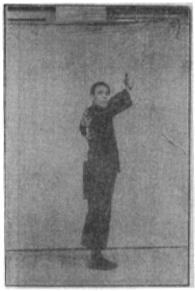
謌曰
Lyrics:
敵人來刺我左肩
白馬分鬃向下點
The opponent attacks with a stab to my left shoulder.
I use WHITE HORSE PARTS ITS MANE to tap downward.
此式面向正東。右手持劍向上作挑式。劍鋒向上。左手劍訣與右手劍式同。兩足並立。是為三斷式第三動作。如敵人來刺左肩。則用劍由上向下刺取敵人之腕。同時右足向左上偸步。其姿式如下。
The posture is now facing to the [south, torso squared to the] east. My right hand is sending my sword upward with a lifting technique so the tip is pointing upward. My left hand as a swordsman’s hex is postured the same way as my sword. My feet are together. This is the third movement of THREE STOPPINGS POSTURE.
If an opponent attacks with a stab to my left shoulder, I send my sword down from above with a stab to his wrist while my right leg steps to the left and forward into a stealth stance. This posture is as in the photo below:
第六十七式 白馬分鬃(一)
POSTURE 67: WHITE HORSE PARTS ITS MANE – Part 1
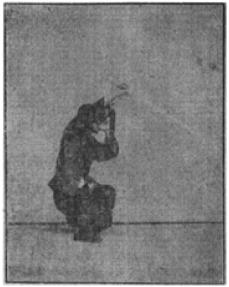
謌曰
Lyrics:
敵人還刺我左肩
白馬分鬃順步翻
The opponent returns a stab to my left shoulder.
I use WHITE HORSE PARTS ITS MANE to turn over with a follow-through step.
此式面向東北。右手持劍,向下作斜刺式。劍鋒微向下。左手副腕,左足在前。右足在後作偸步。是為白馬分鬃第一動作。此式分上中下三招:上用白馬分鬃。中用封侯掛印。下用黃龍擺尾,如敵人還刺左肩。則身隨劍向北翻,擠截敵人之腕。同時兩足作騎馬式。其姿式如下。
The posture is now facing to the northeast. My right hand is sending my sword diagonally downward with a stabbing technique, the tip pointing slightly downward, my left hand assisting at my right wrist. My left leg is in front, right leg behind, making a stealth stance. This is the first movement of WHITE HORSE PARTS ITS MANE.
(Techniques that follow from it for each of the three levels could be: high – WHITE HORSE PARTS ITS MANE, middle – NOBLEMAN HANGS UP HIS SEAL, low – YELLOW DRAGON SWINGS ITS TAIL.)
If the opponent counters with a stab to my left shoulder, my torso goes along with my sword, turning around [to the right] to be squared to the north for it to press out with a checking technique to his wrist. At the same time, my legs are making a horse-riding stance. This posture is as in the photo below:
第六十八式 白馬分鬃(二)
POSTURE 68: WHITE HORSE PARTS ITS MANE – Part 2
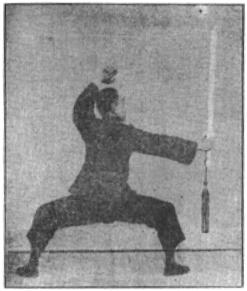
謌曰
Lyrics:
敵人下劍來追趕
快馬加鞭向下攔
The opponent chases with a low attack.
I use QUICKEN THE HORSE WITH MORE WHIPPING to block downward.
此式面向東北。右手持劍,劍鋒向上。左手劍訣,罩於頂前。兩足作騎馬式。是為白馬分鬃第二動作。此式與連環劍第四式名異實同。此式分上中下三招:上用望巧雲。中用仙人指路。下用快馬加鞭。如敵人來刺腿部。則右足向西跳步,左足隨上弓步。同時用劍向下回截敵人之腕。其姿式如下。
The posture is now facing to the northeast. My right hand is holding my sword, the tip pointing upward. My left hand as a swordsman’s hex is placed in front of my headtop. My legs are making a horse-riding stance. This is the second movement of WHITE HORSE PARTS ITS MANE. Although the name is different, it is actually the same as CONTINUOUS SWORD – Part 4.
(Techniques that follow from it for each of the three levels could be: high – GAZING UPON BEAUTIFUL CLOUDS, middle – IMMORTAL POINTS THE WAY, low – QUICKEN THE HORSE WITH MORE WHIPPING.)
If the opponent attacks with a stab to my thigh, my right leg jumps away to the west and my left leg then goes forward [behind] to make a [reverse] bow stance. At the same time, I send my sword downward with another checking technique to his wrist. This posture is as in the photo below:
第六十九式 快馬加鞭
POSTURE 69: QUICKEN THE HORSE WITH MORE WHIPPING
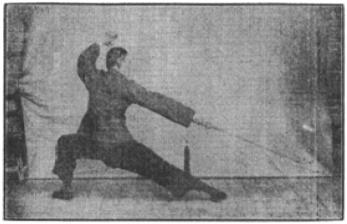
謌曰
Lyrics:
敵人來刺我左肩
羣鴻戲海刁抹攔
The opponent attacks with a stab to my left shoulder.
I use FLOCK OF GEESE GOING OVER THE SEA to hook, smear, and block.
此式身向北,面向東。右手持劍作下攔式。左手劍訣罩於頂前。左足在前,右足在後作弓步。是為快馬加鞭。此式分上中下三招:上用白鶴亮翅。中用橫劍截腕。下用羣鴻戲海。如敵人來刺左肩。則身隨劍轉,向西托取敵人之腕。再刺,則用刁法。同時若後面敵來刺背。則轉身向東捲取敵腕。如敵再由西面來刺。而後再轉身向西橫截敵腕。兩足來回作弓步。劍前後托,刁,捲,攔,凡用四劍。此應敵多人之法也。再此四劍揮動時,左手在後作抅手。旣攔之後,將劍抽回,抱於胸前。同時左足撤作點步。其中運劍之姿式如下。
The posture is now facing to the east, torso squared to the north. My right hand is sending my sword downward with a blocking technique. My left hand as a swordsman’s hex is placed in front of my headtop. My left leg is forward [behind], right leg behind [forward], making a [reverse] bow stance. This is QUICKEN THE HORSE WITH MORE WHIPPING.
(Techniques that follow from it for each of the three levels could be: high – WHITE CRANE SHOWS ITS WINGS, middle – TAKING THE SWORD ACROSS TO CHECK HIS WRIST, low – FLOCK OF GEESE GOING OVER THE SEA.)
If the opponent attacks with a stab to my left shoulder, my torso goes along with my sword as it turns around to the west with a propping technique to his wrist. He stabs again, so I use a hooking technique.
If at the same time, an opponent behind me attacks with a stab to my back, I turn my torso to the east to catch his wrist with a rolling technique.
If the opponent to the west again attacks with a stab, I again turn to face him, going across with a checking technique to his wrist. As I turn to and fro, my legs are making [reverse] bow stances. Back and forth, my sword has performed four actions: prop, hook, roll, block. This is a method of responding to more than one opponent. While these four actions are being wielded, my left hand is behind me, formed as a hook hand. (After blocking, I will retract my sword, embracing it in front of my chest, my left leg withdrawing to make a pointed stance.) This posture is as in the photo below:
第七十式 羣鴻戲海
POSTURE 70: FLOCK OF GEESE GOING OVER THE SEA
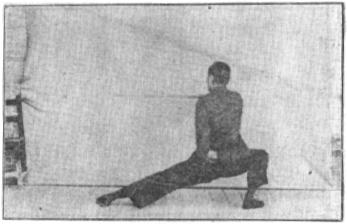
謌曰
Lyrics:
敵人來刺我的面
騰蛇吐信刺胸前
The opponent attacks with a stab to my face.
I use WINGED SERPENT FLICKS ITS TONGUE to stab from in front of my chest.
此式面向正北。右手持劍來回用托,刁,捲,攔,此其中運劍之姿式也。四劍旣畢,將劍平抱胸前。左手副腕。左足在前作點步。是為群鴻戲海。此式分上中下三招:上用藤蘿掛壁。中用騰蛇吐信。下用金針入地。如敵人來刺胸部。則用劍前刺敵人之腕。其姿式如下。
The posture is now facing to the north [west]. My right hand is pulling my sword back in after performing the four actions of prop, hook, roll, and block, bringing it in to be embraced level in front of my chest, my left hand assisting at my right wrist. My left leg is forward making a pointed stance. This is FLOCK OF GEESE GOING OVER THE SEA.
(Techniques that follow from it for each of the three levels could be: high – VINES CLIMBING THE WALL, middle – WINGED SERPENT FLICKS ITS TONGUE, low – GOLDEN NEEDLE INTO THE GROUND.)
If the opponent attacks with a stab to my chest, I send my sword forward to stab to his wrist. This posture is as in the photo below:
第七十一式 騰蛇吐信(一)
POSTURE 71: WINGED SERPENT FLICKS ITS TONGUE – Part 1
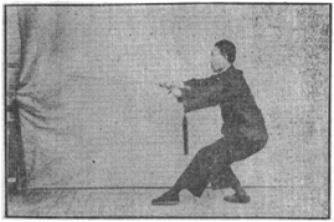
謌曰
Lyrics:
敵人由上向下劈
騰蛇吐信上劍取
The opponent chops down from above.
I use WINGED SERPENT FLICKS ITS TONGUE to send my sword upward.
此式面向正西。右手持劍向前刺平。左手副腕。左足在前作點步。是為騰蛇吐信第一動作。此式分上中下三招:上用騰蛇吐信。中用騰蛇吐信。下用淵明折菊。如敵人劈我面部。則用劍上挑敵人之腕。同時兩足並立。其姿式如下。
The posture is now facing to the west. My right hand is sending my sword forward with a level stab, my left hand assisting at my right wrist. My left leg is forward making a pointed stance. This is the first movement of WINGED SERPENT FLICKS ITS TONGUE.
(Techniques that follow from it for each of the three levels could be: high – WINGED SERPENT FLICKS ITS TONGUE, middle – WINGED SERPENT FLICKS ITS TONGUE, low – TAO YUANMING PLUCKS A CHRYSANTHEMUM.)
If the opponent chops to my face, I send my sword upward with a lifting technique to his wrist, while [stepping forward with my right leg, then left leg, then right leg, then moving my left foot up to stand next my right foot,] bringing my feet together. This posture is as in the photo below:
第七十二式 騰蛇吐信(二)
POSTURE 72: WINGED SERPENT FLICKS ITS TONGUE – Part 2
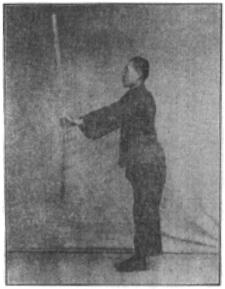
謌曰
Lyrics:
敵人在後刺我背
封侯掛印點掛退
An opponent stabs at me from behind.
I use NOBLEMAN HANGS UP HIS SEAL to do a hanging tap while retreating.
此式面向正西。右手持劍,劍鋒向上作挑式。兩足並立,左手副腕。是為騰蛇吐信第二動作。如敵人在後來刺。則身隨劍向後,自上而下掛點敵人之腕。左足斜舉,右足後立。斜身拗步。其姿式如下。
The posture is now facing to the west. My right hand is sending my sword upward with a lifting technique, my left hand assisting at my right wrist. My feet are together. This is the second movement of WINGED SERPENT FLICKS ITS TONGUE.
If an opponent attacks from behind with a stab, my body goes along with my sword [turning around to the left] as it goes to the rear and down from above with a hanging tap to his wrist, while my left leg angles, right leg standing behind, as I slant my torso to make a twisted stance. This posture is as in the photo below:
第七十三式 封侯掛印(一)
POSTURE 73: NOBLEMAN HANGS UP HIS SEAL – Part 1

謌曰
Lyrics:
敵人來刺我胸前
封侯掛印抅掛連
The opponent attacks with a stab to my chest.
I use NOBLEMAN HANGS UP HIS SEAL to continue into hooking and hanging.
此式面向正東。右手持劍,由上向下作掛點式。劍刃上下向。左手副腕。左足在前斜作點步。是為封侯掛印第一動作。如敵人來刺胸前。則身隨劍左掛右掛敵人之腕。同時右足提起。左手副腕。其姿式如下。
The posture is now facing to the east. My right hand is sending my sword down from above with a hanging tapping technique, the edges up and down, my left hand assisting at my right wrist. My left leg is forward making a pointed [twisted] stance. This is the first movement of NOBLEMAN HANGS UP HIS SEAL.
If the opponent attacks with a stab to my chest, my torso goes along with my sword as it performs left hanging [hooking] and right hanging techniques to his wrist, my left hand assisting at my right wrist, while my right foot lifts. This posture is as in the photo below:
第七十四式 封侯掛印(二)
POSTURE 74: NOBLEMAN HANGS UP HIS SEAL – Part 2
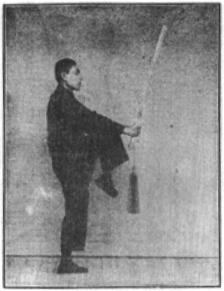
謌曰
Lyrics:
敵人來刺我的膝
葉底藏花抅掛劈
The opponent attacks with a stab to my knee.
I use FLOWER HIDDEN UNDER THE LEAF to do a hook and a hanging chop.
此式面向正東。右手持劍,劍鋒向上。劍刃正對面部。左手副腕。右足提起。左足直立。是為封侯掛印第二動作。此式分上中下三招:上用白鶴亮翅。中用封侯掛印。下用葉底藏花。如敵人來刺膝部。則身隨劍向前左右抅掛敵人之腕。同時右足前落,左足向前作跳步。右足再向前鋪腿。右手持劍。劍鋒向上位於右膝之前。左手副腕。其姿式如下。
The posture is now facing to the east. My right hand is holding my sword, the tip pointing upward, edge straight in front of my face, my left hand assisting at my right wrist. My right leg is lifted, left leg standing straight. This is the second movement of NOBLEMAN HANGS UP HIS SEAL.
(Techniques that follow from it for each of the three levels could be: high – WHITE CRANE SHOWS ITS WINGS, middle – NOBLEMAN HANGS UP HIS SEAL, low – FLOWER HIDDEN UNDER THE LEAF.)
If the opponent attacks with a stab to my knee, my torso goes along with my sword as it performs a left hook and right hang [hanging chop] to his wrist. At the same time, my right foot comes down forward, my left foot jumps forward, then my right foot goes forward again to make a spreading stance. My right hand is holding my sword so the tip is upward, positioned in front of my right knee, my left hand assisting at my right wrist. This posture is as in the photo below:
第七十五式 葉底藏花
POSTURE 75: FLOWER HIDDEN UNDER THE LEAF
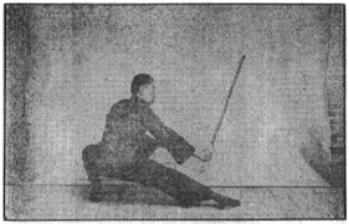
謌曰
Lyrics:
敵人來刺我的腕
黃龍翻身莫遲延
The opponent attacks with a stab to my wrist.
I perform YELLOW DRAGON TURNS AROUND without delay.
此式面向正東。右手持劍,劍鋒向上斜立。劍刃正對面部。左手副腕。右足在前作鋪腿式。是為葉底藏花。此式分上中下三招:上用橫劍截腕。中用黃龍翻身。下用夜叉探海。如敵人來刺腕部。則右手將劍撤回,隨翻身反截敵人之腕。作騎馬式。其姿式如下。
The posture is now facing to the east. My right hand is holding my sword so the tip is pointing diagonally upward, edge straight in front of my face, my left hand assisting at my right wrist. My right leg is forward making a spreading stance. This is FLOWER HIDDEN UNDER THE LEAF.
(Techniques that follow from it for each of the three levels could be: high – TAKING THE SWORD ACROSS TO CHECK HIS WRIST, middle – YELLOW DRAGON TURNS AROUND, low – NIGHT DEMON SEARCHES THE SEA.)
If the opponent attacks with a stab to my wrist, my right hand brings my sword in, then [my left leg steps forward and] I turn my body around [to the right] to counter with a checking technique to his wrist in a horse-riding stance. This posture is as in the photo below:
第七十六式 黃龍翻身
POSTURE 76: YELLOW DRAGON TURNS AROUND
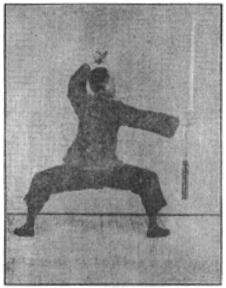
謌曰
Lyrics:
敵人後退不追趕
伏虎各招收式全
The opponent retreats away.
From CROUCHING TIGER POSTURE, I gather in my techniques and finish.
此式面向東,身向北。右手持劍,劍向上立。左手劍訣罩於頂前。兩足作騎馬式。是為黃龍翻身。此式分上中下三招:上用封侯掛印。中用走馬回頭。下用伏虎式。如敵人向西轉,則以伏虎式隨之。用劍鋒向下垂點。同時左足向回撤點步。
The posture is now facing to the east, torso squared to the north. My right hand is holding my sword, the tip pointing up. My left hand as a swordsman’s hex is placed in front of my headtop. My legs are making a horse-riding stance. This is YELLOW DRAGON TURNS AROUND.
(Techniques that follow from it for each of the three levels could be: high – NOBLEMAN HANGS UP HIS SEAL, middle – RUNNING HORSE LOOKS BEHIND, low – CROUCHING TIGER POSTURE.)
If the opponent comes around me to the west, I make the CROUCHING TIGER POSTURE to respond to whatever may follow, my sword tip hanging downward while my left leg withdraws into a pointed stance.
第七十七式 伏虎式
POSTURE 77: CROUCHING TIGER POSTURE
此式見前。昆吾劍法,至此巳畢。則左足撤回,與右足並立,右手持劍橫於腰前,左手握拳抱於脇下,作收式。仍與第一式同。
This posture is as before.
To now conclude the Kunwu sword set, my left foot withdraws to stand next to my right foot. My right hand holds my sword horizontal in front of my waist as my left hand grasps into a fist held below the ribs, making the closing posture the same as Posture 1.
-
昆吾劍十字用法圖說
EXPLANATIONS FOR KUNWU SWORD’S TEN TECHNIQUES
第一圖 托式
TECHNIQUE 1: PROPPING
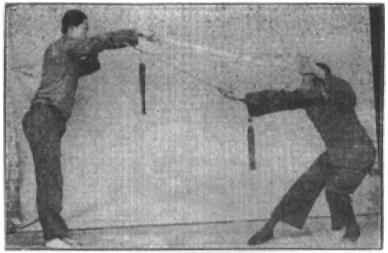
(說明)托式之用法,自下而上,所以制敵人之上劍也。左右前後皆可用。以此式為主。或謂「雲」,或謂「撩」,實即托式也。
敵人用上劍,或來刺,或來點,皆可用此著。如譜中之烏鵲飛空,順風領衣,連環劍之第一第二兩式,海底撈月之第一式,及摘星換月之第一式,皆此「托」字之變化也。
(Explanation)
The propping technique goes up from below to control the opponent’s upward sword. It can be done to the left or right, forward or back, and is the major technique. It is sometimes called “clouding” or “raising”, which are actually the propping technique. If the opponent sends his sword upward and attacks with either a stab or a tap, this technique can be used in both cases.
In the set, is like MAGPIES FLY INTO THE SKY [Posture 44], WIND TUGS AT THE ROBE [Postures 52&53], CONTINUOUS SWORD – Parts 1&2 [Postures 56&56], TRYING TO SCOOP THE MOON’S REFLECTION FROM THE WATER – Part 1 [Posture 39], or PLUCK AWAY THE STARS & REPLACE THEM WITH THE MOON – Part 1 [Posture 59], which are all variations of this propping technique.
第二圖 抹式
TECHNIQUE 2: SMEARING
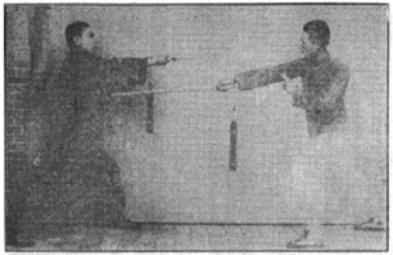
(說明)抹式之用法,所以制敵人之中劍也。此劍走敵人之外門,或謂之「撥」,或謂之「錯」,皆此字之變化也。
如敵人來刺中劍,便可用此法由左前方追取敵人之腕。譜中之抹式副手即如此用。
(Explanation)
The smearing technique is for controlling the opponent’s sword when at the middle height, my sword running to his outer gate. It is sometimes called “deflecting” or “grinding”, which are both variations of this technique. If the opponent attacks with a level stab, this can easily be applied from the forward left to chase and catch his wrist.
In the set, an example of this technique is SMEARING TECHNIQUE WITH ASSISTING HAND [Posture 15].
第三圖 捧式
TECHNIQUE 3: CARRYING
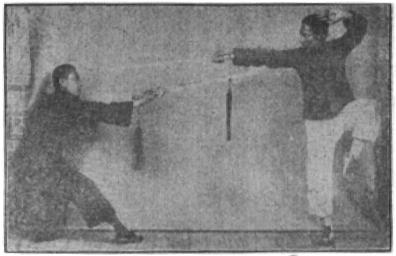
(說明)捧式之用法,所以巧取敵人之底腕也。如敵人用中劍來刺或點,皆可用之。
譜中之祥雲捧日,內提金爐,黃龍擺尾之第二式與劍刺三里之第一式,皆捧式也。
(Explanation)
The carrying technique is for catching the opponent under his wrist. If he uses his sword to attack at the middle height with a stab or tap, this can be applied in either case.
In the set, it is like PROPITIOUS CLOUDS CARRY THE SUN [Posture 16], INWARD SPARKING-THE-GOLDEN-FURNACE [Posture 21], YELLOW DRAGON SWINGS ITS TAIL – Part 2 [Postures 28&34], or SWORD STABS THE LENGTH OF A MILE – Part 1 [Posture 46], which are all versions of this carrying technique.
第四圖 點式
TECHNIQUE 4: TAPPING
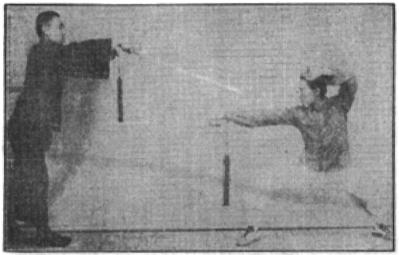
(說明)點式之用法,自上而下,以制敵人之中劍。或謂之「劈」,或謂之「坎」,或謂之「挅」,名異而實同也。
譜中之蜻蜓點水,力劈華山,靈貓捕鼠,金雞點頭第二式,打落金錢,三斷第二式,皆點法也。
(Explanation)
The tapping technique goes down from above to control the opponent’s sword when at the middle height. It is sometimes called “chopping”, “hacking”, or “cleaving”, and although the names are different, they are actually the same thing.
In the set, it is like DRAGONFLY SKIMS THE WATER [Postures 3&18], POWERFUL CHOP THROUGH MT. HUA [Posture 10], QUICK CAT CATCHES THE MOUSE [Posture 43], GOLDEN ROOSTER PECKS WITH ITS HEAD – Part 2 [Posture 24], SLAMMING DOWN MONEY [Posture 54], or THREE STOPPINGS – Part 2 [Posture 65], which are all methods of tapping.
第五圖 捲式
TECHNIQUE 5: ROLLING
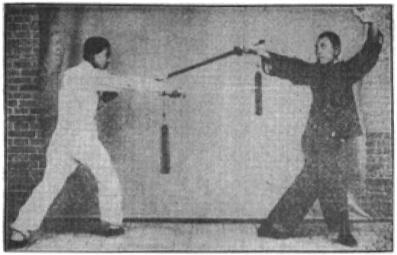
(說明)捲式之用法,上下,左右,前後,隨處可用。或謂之「剪」,或謂之「圈」,其實一也。
譜中之珠簾倒捲,黃龍擺尾之第一式,走馬回頭之第一式,皆此法之變化也。
(Explanation)
The rolling technique can be done upward or downward, to the left or right, forward or back, according to the moment. It is sometimes called “shearing” or “circling”, and are actually all the same thing.
In the set, it is like BEADED CURTAIN IS ROLLED AWAY [Postures 11&12], YELLOW DRAGON SWINGS ITS TAIL – Part 1 [Postures 27&33], or RUNNING HORSE LOOKS BEHIND – Part 1 [Posture 62], which are all variations of this technique.
第六圖 刁式
TECHNIQUE 6: HOOKING
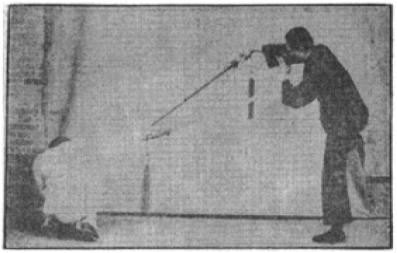
(說明)刁式之用法,或謂之「削」。或謂之「掃」。或謂之「摽」。
譜中之摘星換月第二式,即此法也。
(Explanation)
The hooking technique is sometimes called “whittling”, “sweeping”, or “scraping”.
In the set, an example of this technique is PLUCK AWAY THE STARS & REPLACE THEM WITH THE MOON – Part 2 [Posture 60].
第七圖 掛式
TECHNIQUE 7: HANGING

(說明)掛式之用法,上下,左右,前後皆可用。或謂之「挑」,或謂之「撩」,皆掛法也。
譜中之氷著垂簷,外提金爐,金雞點頭第一式第三式,黃龍擺尾第四式,平地挿香,藤蘿掛壁,三斷第一式,騰蛇吐信第二式,白馬分鬃,封侯掛印,葉底藏花,皆掛法之變化也。
(Explanation)
The hanging technique can be used upward, downward, to the left or right, forward or back. It is sometimes called “lifting” or “raising”, both of which are the hanging technique.
In the set, this is like ICICLE HANGING FROM THE EAVES [Posture 20], OUTWARD SPARKING-THE-GOLDEN-FURNACE [Posture 22], GOLDEN ROOSTER PECKS WITH ITS HEAD – Parts 1&3 [Postures 23&25], YELLOW DRAGON SWINGS ITS TAIL – Part 4 [Postures 30&36], INSERTING A STICK OF INCENSE INTO LEVEL GROUND [Posture 48], VINES CLIMBING THE WALL [Posture 49], THREE STOPPINGS – Part 1 [Posture 64], WINGED SERPENT FLICKS ITS TONGUE – Part 2 [Posture 72], WHITE HORSE PARTS ITS MANE [(Part 2) Posture 68], NOBLEMAN HANGS UP HIS SEAL [Postures 73&74], or FLOWER HIDDEN UNDER THE LEAF [Posture 75], which are all variations of the hanging technique.
第八圖 折式
TECHNIQUE 8: BREAKING
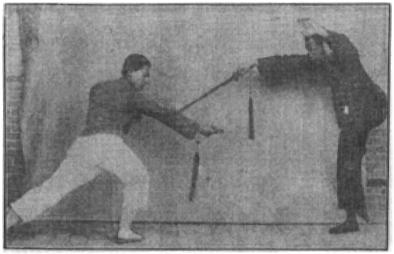
(說明)折式之用法,上下,左右,前後皆可。或謂之「攔」,或謂之「截」。
譜中之橫劍截腕,白鶴亮翅,金針入地,珠簾倒捲第一式,千金墜地,仙人入洞,淵明折菊,夜叉探海,望巧雲,浩然折梅,快馬加鞭,皆此法之變化也。
(Explanation)
The breaking technique can be done upward or downward, to the left or right, forward or back. It is sometimes called “blocking” or “checking”.
In the set, it is like TAKING THE SWORD ACROSS TO CHECK HIS WRIST [Posture 2], WHITE CRANE SHOWS ITS WINGS [Posture 8], GOLDEN NEEDLE INTO THE GROUND [Posture 9], BEADED CURTAIN IS ROLLED AWAY – Part 1 [Posture 11], A THOUSAND POUNDS DROP TO THE GROUND [(Part 1) Posture 13], IMMORTAL GOES INTO HIS CAVE [Posture 17], TAO YUANMING PLUCKS A CHRYSANTHEMUM [Postures 32&38], NIGHT DEMON SEARCHES THE SEA [Posture 41], GAZING UPON BEAUTIFUL CLOUDS [Posture 42], MENG HAORAN PLUCKS A PLUM [Posture 45], or QUICKEN THE HORSE WITH MORE WHIPPING [Posture 69], which are all variations of this technique.
第九圖 刺式
TECHNIQUE 9: STABBING

(說明)刺式之用法,至為顯明。方向不定,乘際而發,進攻之着法也。刺出之時,劍刃或左右向,或上下向均可,視走劍之便利而定。或謂平刺為「刺」,立刺為「扎」,其實無須强為分別也。
譜中如仙人指路,劍刺三里,遮前擋後,騰蛇吐信之類,皆刺式也。
(Explanation)
The stabbing technique is the most obvious. The direction is not consistent and it is applied according to opportunity. It is a method of attacking forward. When stabbing out, the sword edges can be either left/right or up/down, whatever appears to be convenient at the time. Some people call a stab with the blade flat a “stab” and a stab with the blade vertical a “poke” [and vice versa], but such differentiating is not actually necessary [seeing as they are both stabs].
In the set, it is like IMMORTAL POINTS THE WAY [Posture 5], SWORD STABS THE LENGTH OF A MILE [(Part 2) Posture 47], COVER IN FRONT & BLOCK BEHIND [Postures 50&51], and WINGED SERPENT FLICKS ITS TONGUE [(Part 1) Posture 71], which are all stabbing postures.
第十圖 站式
TECHNIQUE 10: STANDING

(說明)站式之為用,看似簡單,實為最難。因着法未發之先,須詳察敵人之動靜,而後因利乘便,一發制人也。
譜中如迎門獻劍,固為站式。實際其他定式,均為站式也。學者不可狃於俗見,而誤解兩足並立,始為站式也。
(Explanation)
The standing technique looks simple but is actually the most difficult, because it is the technique before techniques emerge. You must examine the opponent’s activity to thereby execute the techniques that would be most likely to defeat him.
In the set, it is like PRESENTING THE SWORD BEFORE THE GATE [Posture 1], which is indeed a standing posture. Actually the rest of the static postures are all standing postures too, and you must not look upon it in overly literal way by mistaking the feet-together position as being the only kind of standing posture.
FOUND: HERE
Subscribe to:
Posts (Atom)
